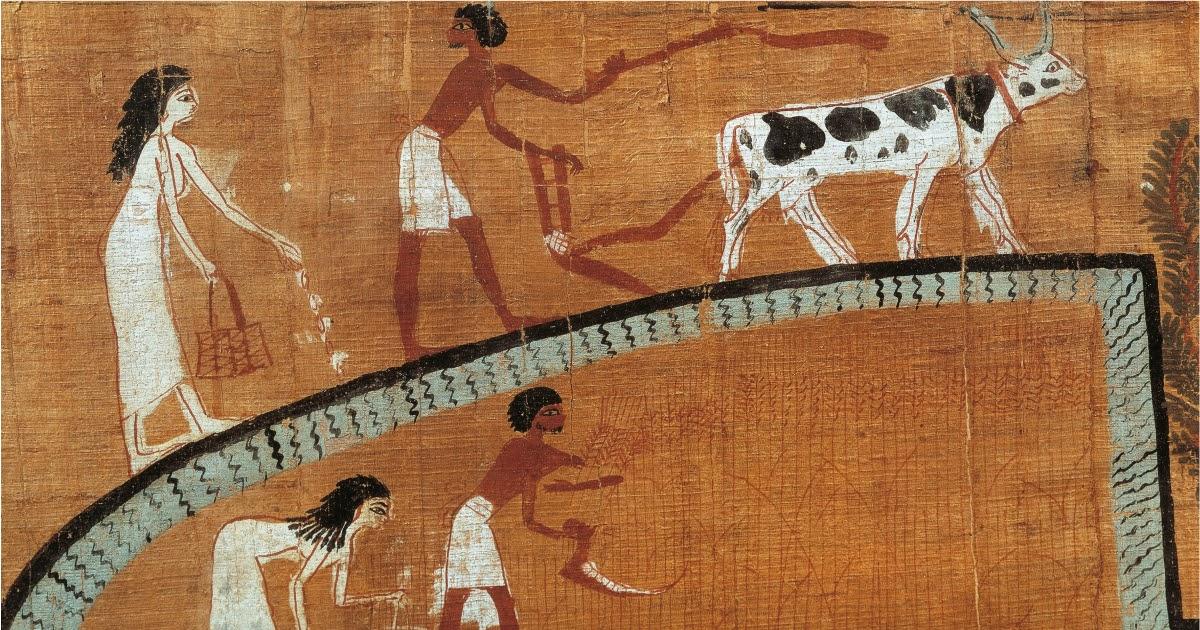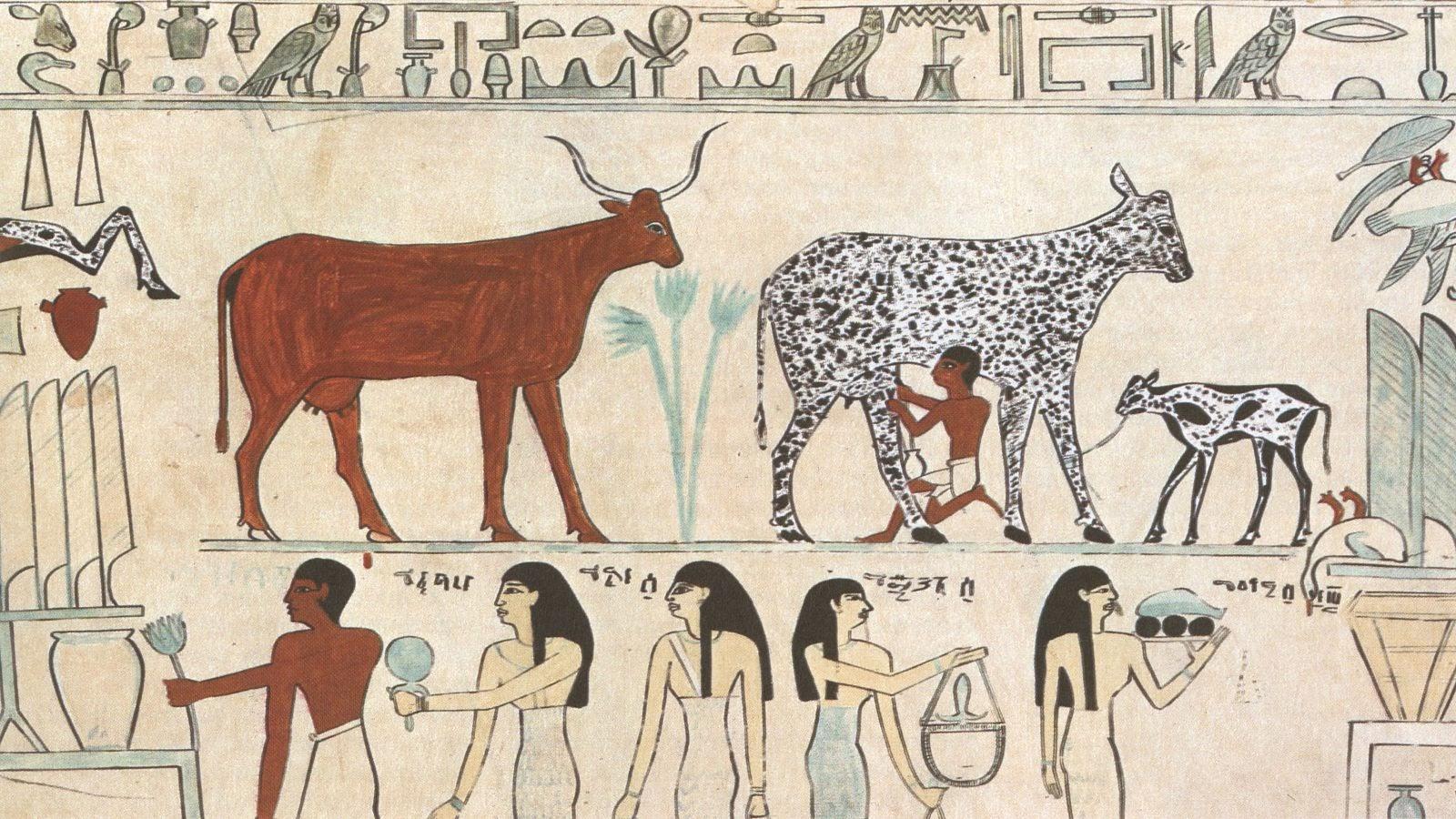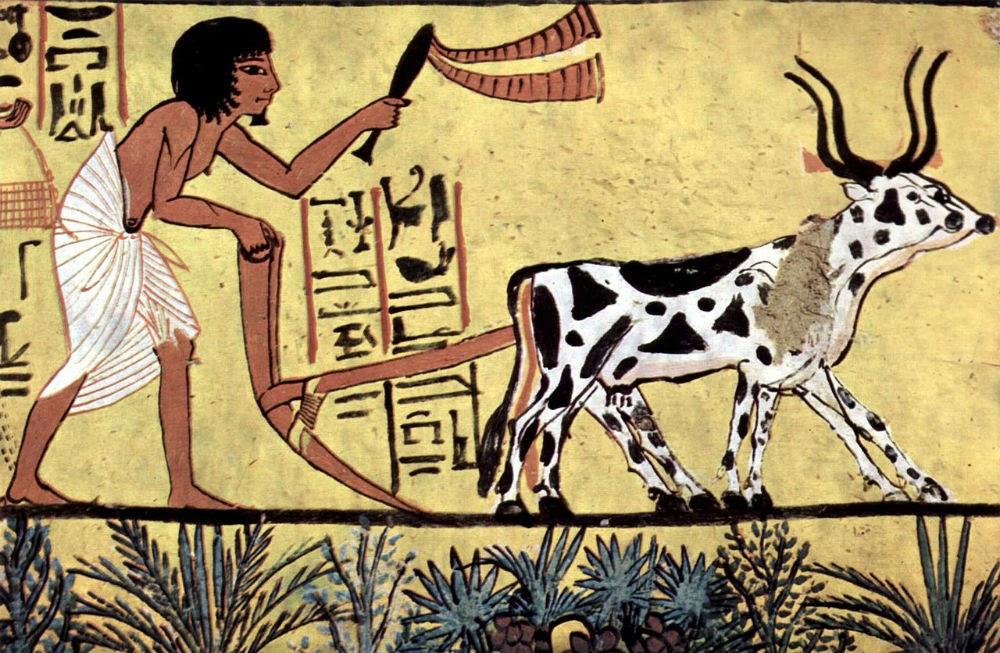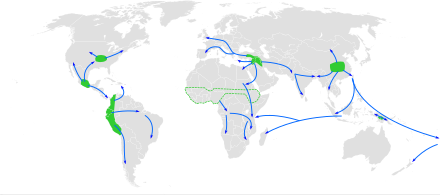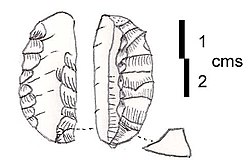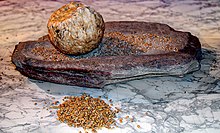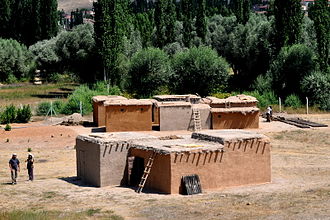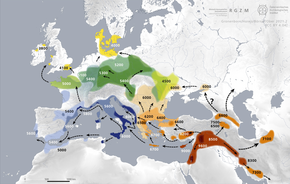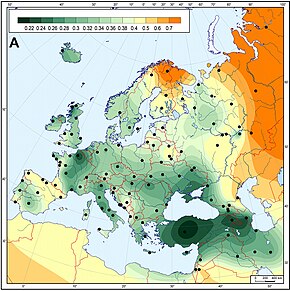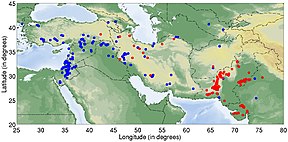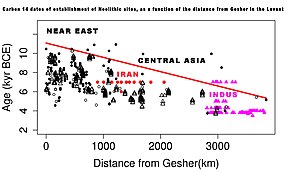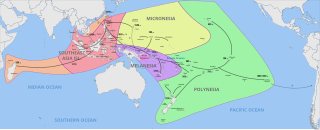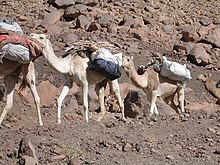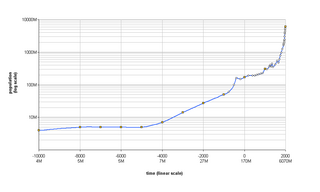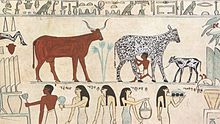2 года назад · 28117 просмотров
Неолитическая революция – суть понятия. Обществознание, 6 класс. Неолитической революцией называют переход от присваивающего хозяйства к производящему. Неолитическая революция: первые скотоводы, земледельцы, ремесленники. Каковы ее причины и последствия?
DEA / A. DAGLI ORTI/De Agostini via Getty Images
Неолитическая революция — это переход от присваивающего хозяйства к производящему. Когда люди вместо охоты и собирательства стали заниматься сельским хозяйством, научились выращивать растения и разводить животных, заниматься ремеслом, — это и была неолитическая революция.
- Революция — коренное изменение большинства сторон общественной жизни, радикальная смена строя. Революции бывают краткосрочные, а бывают долгосрочные. Неолитическая революция — долгосрочная, она продолжалась несколько тысячелетий.
Эта аграрная (сельскохозяйственная) революция называется неолитической, потому что происходила в эпоху неолита — в новом каменном веке. Предположительно, одомашнивание животных началось 12–10 тысяч лет назад на Ближнем Востоке. Примерно тогда же люди начали выращивать растения — например, ячмень и пшеницу.
То же самое стало происходить и в других частях мира — например, в Индии и в Китае. Вероятнее всего, в отдельных регионах до производящего хозяйства люди додумались самостоятельно. При этом и сегодня кое-где в отдаленных уголках планеты люди живут охотой и собирательством, там неолитическая революция так и не произошла.
Карта зарождения и распространения сельского хозяйства. Wikimedia / Joe Roe
Термин «неолитическая революция» ввел в оборот в 1923 году археолог Гордон Чайлд, изучавший истоки европейской цивилизации. Он также писал об «урбанистической революции», связанной с возникновением городов.
Причины неолитической революции
Гордон Чайлд связывал неолитическую революцию с окончанием ледникового периода и изменениями климата, заставившими людей мигрировать в плодородные оазисы. Там якобы они приручили животных и одомашнили растения. Но в дальнейшем эта гипотеза не нашла подтверждений.
Возможно, у неолитической революции были демографические причины: численность людей росла, охота и собирательство уже не могли их прокормить. К тому же, исчезла мегафауна — огромные животные, охота на которых позволяла быстро добывать массу пищи. Тогда-то людям пришлось научиться самим разводить животных и выращивать зерно.
Предпосылкой перехода к производящему хозяйству могло стать постепенное накопление знаний, взаимное приспособление человека и природы. Не исключено, что люди сначала защищали дикорастущие растения, чтобы те успели созреть, а затем догадались сажать их сами. Нечто подобное могло произойти и с животными: сначала люди охотились на дикие стада, потом взяли их под опеку и наконец полностью одомашнили.
Одомашненные коровы дают молоко. Древнеегипетское изображение. Источник: Википедия
Вероятно также, что земледелие стало возможным благодаря стабилизации климата: погода и смена сезонов стали более предсказуемыми, что позволило людям планировать наперед и заниматься сельским хозяйством.
Последствия неолитической революции
Неолитическая революция стала самым важным изменением за время существования человечества.
Человек разумный существует на Земле не меньше 200 тысяч лет, и большую часть этого времени (как минимум 190 тысяч лет) все люди жили небольшими группами охотников и собирателей. Лишь с появлением производящего хозяйства ситуация начала меняться.
Благодаря сельскому хозяйству производительность труда повысилась, пищи стало больше. Население стало быстро расти.
Произошло разделение труда: одни стали земледельцами, другие — скотоводами, третьи — ремесленниками. Кто-то продолжил заниматься охотой, но это уже была отдельная профессия. Возник товарообмен, зародилась торговля.
Вместо отдельных небольших групп охотников появились крупные общности людей; вместо родовой общины — соседская. Стали возникать первые города.
Реконструкция домов эпохи позднего неолита. Ашиклы-Хююк, Турция. Фото: Wikimedia / Sarah Murray
Для защиты и нападения на соседей создавались вооруженные отряды, первые армии. Возникла необходимость в управленцах, политической власти. К третьему тысячелетию до н.э. появились первые государства: цивилизация возникла в Месопотамии, Египте, Индии, Китае.
Так образовалось традиционное аграрное общество, просуществовавшее несколько тысяч лет.
Крестьянин пашет поле. Роспись из древнеегипетской гробницы. Источник: Википедия
К концу неолитической революции люди изобрели письменность, и теперь информацию можно было передавать не просто из уст в уста. Это резко ускорило накопление знаний, развитие научного прогресса и культуры, привело в итоге к появлению современной цивилизации.
Посуда эпохи неолита, найденная в Швейцарии. Фото: Wikimedia / Sandstein
Порой неолитическую революцию рассматривают не только как позитивное явление. Перейдя к производящему хозяйству, люди вступили в противоречие с природой. Они променяли естественную для своего вида охоту на монотонный сельскохозяйственный труд. Изменились диета и образ жизни, свойственные человеку. Человек стал менять окружающую среду, приспосабливая ее к своим потребностям, это приводило к экологическим проблемам.
И все же для людей неолитическая революция стала огромным благом. Благодаря развитию технологий и знаний люди стали лучше питаться, дольше жить, больше знать о мире и о себе. Все блага современной цивилизации были бы невозможны, если бы 10 тысяч лет назад люди не сделали первый шаг к ним, перейдя от охоты и собирательства к сельскому хозяйству и ремеслу.
Неолитическая революция — это переход от присваивающего хозяйства к производящему. Когда люди вместо охоты и собирательства стали заниматься сельским хозяйством, научились выращивать растения и разводить животных, заниматься ремеслом, — это и была неолитическая революция.
- Революция — коренное изменение большинства сторон общественной жизни, радикальная смена строя. Революции бывают краткосрочные, а бывают долгосрочные. Неолитическая революция — долгосрочная, она продолжалась несколько тысячелетий.
Эта аграрная (сельскохозяйственная) революция называется неолитической, потому что происходила в эпоху неолита — в новом каменном веке. Предположительно, одомашнивание животных началось 12–10 тысяч лет назад на Ближнем Востоке. Примерно тогда же люди начали выращивать растения — например, ячмень и пшеницу.
То же самое стало происходить и в других частях мира — например, в Индии и в Китае. Вероятнее всего, в отдельных регионах до производящего хозяйства люди додумались самостоятельно. При этом и сегодня кое-где в отдаленных уголках планеты люди живут охотой и собирательством, там неолитическая революция так и не произошла.
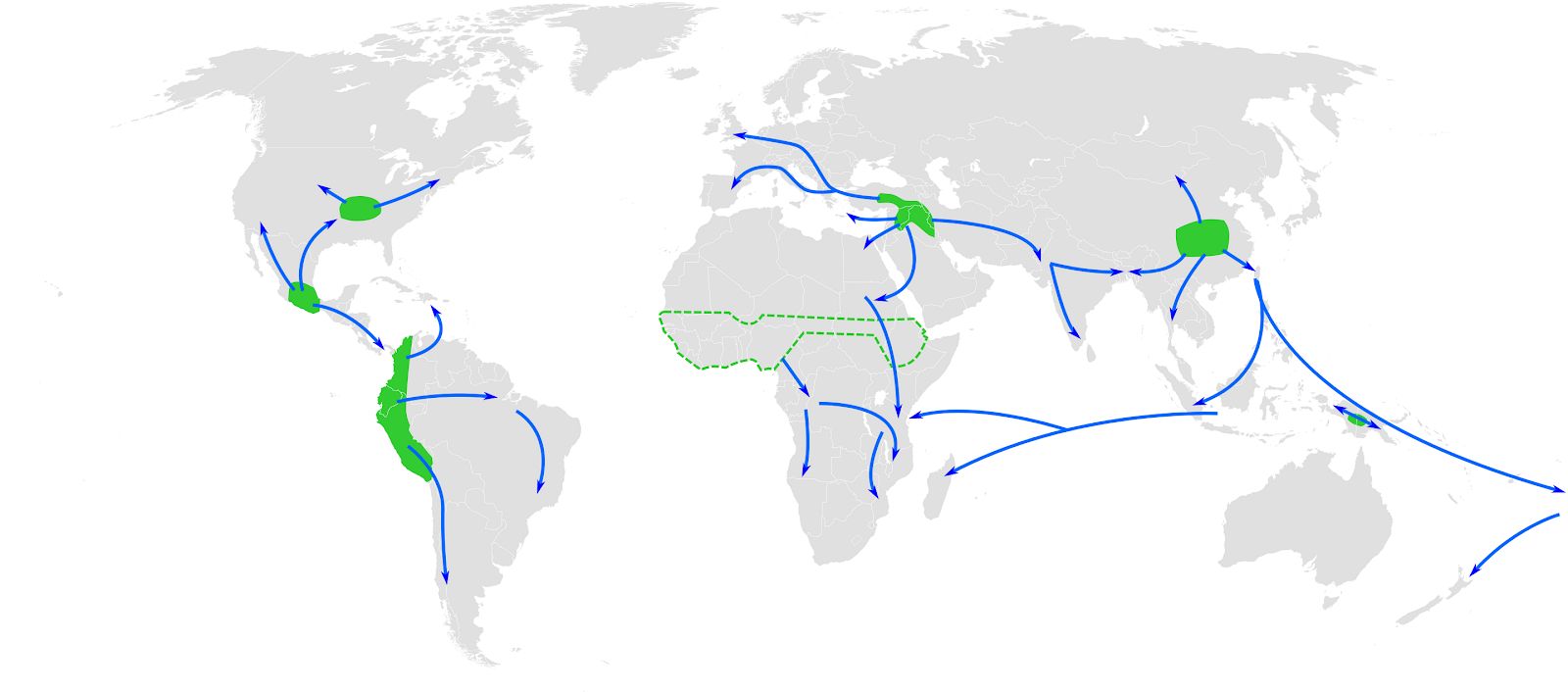
Термин «неолитическая революция» ввел в оборот в 1923 году археолог Гордон Чайлд, изучавший истоки европейской цивилизации. Он также писал об «урбанистической революции», связанной с возникновением городов.
Причины неолитической революции
Гордон Чайлд связывал неолитическую революцию с окончанием ледникового периода и изменениями климата, заставившими людей мигрировать в плодородные оазисы. Там якобы они приручили животных и одомашнили растения. Но в дальнейшем эта гипотеза не нашла подтверждений.
Возможно, у неолитической революции были демографические причины: численность людей росла, охота и собирательство уже не могли их прокормить. К тому же, исчезла мегафауна — огромные животные, охота на которых позволяла быстро добывать массу пищи. Тогда-то людям пришлось научиться самим разводить животных и выращивать зерно.
Предпосылкой перехода к производящему хозяйству могло стать постепенное накопление знаний, взаимное приспособление человека и природы. Не исключено, что люди сначала защищали дикорастущие растения, чтобы те успели созреть, а затем догадались сажать их сами. Нечто подобное могло произойти и с животными: сначала люди охотились на дикие стада, потом взяли их под опеку и наконец полностью одомашнили.

Вероятно также, что земледелие стало возможным благодаря стабилизации климата: погода и смена сезонов стали более предсказуемыми, что позволило людям планировать наперед и заниматься сельским хозяйством.
Последствия неолитической революции
Неолитическая революция стала самым важным изменением за время существования человечества.
Человек разумный существует на Земле не меньше 200 тысяч лет, и большую часть этого времени (как минимум 190 тысяч лет) все люди жили небольшими группами охотников и собирателей. Лишь с появлением производящего хозяйства ситуация начала меняться.
Благодаря сельскому хозяйству производительность труда повысилась, пищи стало больше. Население стало быстро расти.
Произошло разделение труда: одни стали земледельцами, другие — скотоводами, третьи — ремесленниками. Кто-то продолжил заниматься охотой, но это уже была отдельная профессия. Возник товарообмен, зародилась торговля.
Вместо отдельных небольших групп охотников появились крупные общности людей; вместо родовой общины — соседская. Стали возникать первые города.

Для защиты и нападения на соседей создавались вооруженные отряды, первые армии. Возникла необходимость в управленцах, политической власти. К третьему тысячелетию до н.э. появились первые государства: цивилизация возникла в Месопотамии, Египте, Индии, Китае.
Так образовалось традиционное аграрное общество, просуществовавшее несколько тысяч лет.

К концу неолитической революции люди изобрели письменность, и теперь информацию можно было передавать не просто из уст в уста. Это резко ускорило накопление знаний, развитие научного прогресса и культуры, привело в итоге к появлению современной цивилизации.

Порой неолитическую революцию рассматривают не только как позитивное явление. Перейдя к производящему хозяйству, люди вступили в противоречие с природой. Они променяли естественную для своего вида охоту на монотонный сельскохозяйственный труд. Изменились диета и образ жизни, свойственные человеку. Человек стал менять окружающую среду, приспосабливая ее к своим потребностям, это приводило к экологическим проблемам.
И все же для людей неолитическая революция стала огромным благом. Благодаря развитию технологий и знаний люди стали лучше питаться, дольше жить, больше знать о мире и о себе. Все блага современной цивилизации были бы невозможны, если бы 10 тысяч лет назад люди не сделали первый шаг к ним, перейдя от охоты и собирательства к сельскому хозяйству и ремеслу.
7 марта 2021
Обновлено: 12.02.2023
Неолитическая революция — это переход человечества от присваивающего хозяйства к производящей экономике, в своём составе имеющей сельскохозяйственные подотрасли (скотоводство и земледелие), а также выделяющееся ремесло.
Неолитическая революция
Около 11 тысяч лет назад отношения человека с природой кардинально меняются. Зарождаются земледелие и животноводство. Люди целенаправленно производят необходимые продукты. Отныне они меньше зависели от среды. Тип хозяйства получил название производящего. До сих пор производящее хозяйство лежит в основе жизни человечества.
У многих племен переход к производящему хозяйству начался в мезолите и завершился в начале неолита. Появление производящего хозяйства за короткое время изменило жизнь людей, взаимоотношения в человеческих сообществах, порядок управления. Историки назвали эти перемены неолитической революцией.
Причины неолитической революции
Около 12 тысяч лет назад начал быстро таять ледник. За небольшой период тундра и бывшая территория ледника покрылись лесами. Казалось, что эти перемены пойдут человеку на пользу. Однако мамонты и другие крупные животные вымерли, а именно они в течение тысячелетий давали людям основную пищу. Человек начал осваивать охоту на птицу, мелкую дичь, уделять внимание ловле рыбы.
В период мезолита охотники изобрели лук со стрелами. Добычу теперь можно было поражать издали. На принципах действия лука были созданы ловушки и капканы. Еще одним изобретением был бумеранг, имевший свойство возвращаться назад при неудачном броске. Стали строить плоты и лодки. На них плавали по рекам и озерам, и даже выходили в море.
Готовые работы на аналогичную тему
Таяние ледника наиболее тяжкие последствия имело для населения Передней Азии (территория современных Сирии, Турции, Палестины, Израиля, Ирана, Ирака). В палеолите здесь охотились на диких кабанов, козлов, баранов, быков, собирали дикорастущие пшеницу, ячмень, просо. В диком виде эти растения растут лишь в горных районах Передней Азии. Для срезания колосьев изобрели серп.
Внутри деревянной изогнутой рукоятки вытачивался паз, в который вплотную друг к другу вставляли остро заточенные камни в 1-2 см длиной и закрепляли их смолой. Если один камушек выпадал или ломался, его заменяли другим, поскольку они имели стандартную форму. Ученые эти изделия называют микролитами. В мезолите различные микролиты распространились по Евразии и Африки. Их вставляли в серпы, в ножи, топоры, копья, мечи, стрелы.
В период таяния ледников в Передней Азии началась засуха, что привело к гибели растений и животных. Экологический кризис заставлял людей искать новые источники существования. Выход нашли в выращивании животных и разведении растений.
Зарождение производящего хозяйства
Собиратели растений заметили: если зарыть зерна в рыхлую землю и постоянно поливать водой, то из зерна вырастет колос. Так зародилось земледелие. Каждый год для посева отбирали лучшие зерна. Со временем изменились вид и полезные свойства растений.
В условиях засухи животные стали меньше бояться человека и даже заходили в селения в поисках воды. Охотники их ловили, держали в особых загонах и съедали по необходимости. Некоторые животные рождались в неволе. Со временем именно рожденные в неволе животные становились основным источником мяса. За ними ухаживали, их пасли, отбирали для размножения. Домашние животные отличались от диких предков по характеру, повадкам и даже по строению. Произошла доместикация (одомашнивание) животных. Появилось скотоводство.
Злаковые культуры и животные, одомашненные жителями Передней Азии, остаются и поныне основным источником пищи для людей.
Древнейшая стоянка, имеющая следы сельского хозяйства, Зави Чеми Шанидар раскопана в северном Ираке и датируется IX тысячелетием до н. э.
Первыми в X—IX тысячелетиях до н. э. были одомашнены овцы и козы, в VII тысячелетии до н.э. люди приручили корову и свинью. В древности произошла доместикация кошки, спасавшей зерно от грызунов.
Первыми из растений одомашнили ячмень, просо, несколько видов пшеницы и чечевицу. Позже научились выращивать груши, персики, сливы, яблоки, абрикосы, виноград.
Земледелие и скотоводство зародились в оазисах Азии 11 тысяч лет назад. Позднее климат становился более влажным, и сельское хозяйство распространялось по Передней Азии и соседним территориям (Египет, Средняя Азия, Балканский полуостров). Большую роль в неолитической революции сыграло переселение племен. На новых землях выводились новые культуры растений и одомашнивались новые животные.
Последствия неолитической революции
Вслед за появлением сельского хозяйства было сделано множество других открытий. Люди стали производить льняные и шерстяные ткани. Важнейшим изобретением была керамика (первые образцы датированы VIII тысячелетием до н.э.). Ряд племен использовал гончарный круг. Из глины изготавливались кирпичи.
Для полива строились бассейны и примитивные каналы, постепенно ирригационные сооружения усложнялись. Для обработки земли придумали плуги и сохи. Продолжительное время их тянули люди. Позже стали впрягать быков.
В поселении скотоводов и земледельцев VIII тысячелетия до н. э. Чайёню в Малой Азии найдены изделия из меди (самородной). В V тысячелетии до н. э. на Ближнем Востоке начался период энеолита — меднокаменного века. В Европе начало энеолита датируется III тысячелетием до н.э. В конце IV тысячелетия до н.э. на Ближнем Востоке начался бронзовый век, а во II тысячелетии до н.э. в Европе.
Неолитическая революция – переход человека от присваивающего к производящему хозяйству. Это привело к резкому ускорению исторического развития.
2. Перечислите явления, свидетельствовавшие о начале распада первобытнообщинного строя.
Выделение старейшин и вождей, которые управляли своими соплеменниками; появилось социальное неравенство; зарождалась эксплуатация; осуществление власти над людьми (формирование вождества); самостоятельное ведение хозяйства.
3. В чём причина появления у людей значительного количества излишков продуктов?
Появление металлических орудий труда значительно облегчило труд человека, особенно в земледелии. Люди стали производить намного больше продуктов, чем требовалось для собственного потребления.
4. Как повлияло появление излишков продуктов на жизнь людей?
Появление излишков позволяло племенам обмениваться продуктами. Земледельческие племена стали отделяться от скотоводческих.
5. Кого называют ремесленниками?
Люди, занимавшиеся обработкой железа и изготовлением из него разных предметов, изготовлением посуды на гончарном круге, тканей, назывались ремесленниками.
Переход к производящему хозяйству считается важным событием в истории человечества потому, что он кардинально изменил жизнь людей. Этот переход повлиял не только на форму хозяйствования, но и на развитие орудий труда, и на устройство общества. Он привел к распаду первобытно-общинного строя, появлению и объединению соседских общин, а в последствии – к формированию этносов.
2. В каком районе Земли впервые появилось земледелие и скотоводство?
По современным данным земледелие впервые появилось на Ближнем Востоке и Юго-Восточной Азии, а скотоводство – в Азии (Индии и Индокитае).
3. Почему переход к производящему хозяйству называют революцией? Что хотят подчеркнуть, используя это слово?
Вопросы к параграфу
1. Какие изменения в жизни людей произошли с переходом к производящему хозяйству?
- Зарождается земледелие. Люди собирают, сажают и выращивают семена диких растений.
- Появляются специальные орудия для обработки земли.
- Приручение диких животных. Разведение животных. Зарождение скотоводства.
- Люди постепенно переходят от присвоения к производству необходимых для жизни продуктов.
- Появляются излишки продуктов.
2. Назовите главные признаки первобытно-общинного строя.
- Примитивные орудия труда.
- Коллективный труд.
- Общинная собственность.
- Уравнительное распределение продуктов труда.
- Зависимость человека от природы.
3. Перечислите явления, свидетельствовавшие о начале распада первобытно-общинного строя.
- Из членов родовой общины выделяются те, кто управляет общинниками – старейшины и вожди. Старейшины руководят совместными работами, контролируют обмен продуктами, следят за соблюдением установившихся порядков и традиций. Вожди организуют защиту от врагов и возглавляют военные походы.
- Социальное неравенство. С появлением излишков и развитием обмена запасы накапливаются в руках старейшин и вождей и передаются по наследству.
- Появляется эксплуатация чужого труда. Пленные и рабы трудятся вместо своих владельцев, богатых людей.
- Формируются соседские общины, в которых на одной территории проживают несколько родов.
- Общины объединяются под властью верховного вождя.
- Начинают формироваться этносы (народности).
4. Как повлияло использование железных орудий труда на появление излишков продуктов? Почему этих излишков не было, когда люди использовали каменные орудия?
С помощью железных орудий труда люди могли эффективнее обрабатывать землю или охотиться. Люди стали производить намного больше продуктов, чем требовалось для собственного потребления. Появились излишки. Использование каменных орудий было малоэффективным. С их помощью люди производили меньше продуктов, поэтому излишков не было.
Определите по карте, как происходило расселение людей на современной территории нашей страны, найдите центры древнего земледелия, скотоводства, ремесла.
Рассмотрим карты, расположенные на странице 2 и 3 в атласе по истории России.
На большой карте показано, что:
- люди стали расселяться на территории нашей страны более 12 тысяч лет назад (в эпоху плейстоцена — зелёные стрелочки). Они приходили с территории современной Европы, Средней Азии и Китая;
- в IV-II тысячелетии до нашей эры существовала Майкопская археологическая культура в степях и предгорьях Северного Кавказа (фиолетовый контур);
- также, примерно в это же время (3200-2400 гг. до нашей эры), чуть севернее Майкопской культуры находились очаги Древнеямной культуры (голубой контур), территория расположения которых охватывала степные равнины от реки Днестр до южных предгорий Уральских гор;
- в III-II тысячелетии до нашей эры на территории Алтайского края находилась Афанасьевская археологическая культура (розовый контур);
- и в это же время (III-II век до нашей эры) наблюдается рассвет Волосовской археологической культуры, занимавшей территорию Центральной России и Среднего Поволжья (оранжевый контур).
Глядя на малую карту мы видим, что:
- на территории Крыма и Красноярского края развитые культуры находились уже в VI-III веке до нашей эры, то есть ещё раньше, чем в других российских регионах.
Вывод: расселение людей происходило постепенно от южных территорий к более северным, а очаги культуры появлялись в следующем порядке:
- Древнеримские колонии (VI век до нашей эры);
- Боспорское царство (VI век до нашей эры);
- Майкопская археологическая культура (IV век до нашей эры);
- Древнеямная культура (IV век до нашей эры);
- Афанасьевская археологическая культура (III-II век до нашей эры);
- Волосовская археологическая культура (III-II век до нашей эры).
Центрами древнего земледелия находились в Крыму и в Краснодарском крае, центры ремесла — на Южном Урале, а центры скотоводства охватывали всю Среднюю полосу России и южные районы Сибири.
Думаем, сравниваем, размышляем
1. Проследите, как и почему менялась организация жизни древних людей. Каковы причины появления соседской общины и в чём её отличия от родовой?
С началом обработки металлов, появились более совершенные орудия труда. Жизнь людей стала легче. Они могли более эффективно обрабатывать землю или охотиться, что привело к появлению излишков продуктов. Приручение животных положило начало скотоводству. Стал возможен обмен излишками продуктов между племенами. В зависимости от климатических особенностей территории началось разделение племен на земледельческие и скотоводческие. Племена, которые занимались земледелием стали вести оседлый образ жизни, а скотоводческие племена осваивали степные просторы.
Совершенствование орудий труда позволяло отдельным семьям вести хозяйство самостоятельно. Родовые узы слабели. Отдельные семьи покидали соплеменников и селились в других общинах. Появились территориальные (соседские) общины. В таких общинах людей объединяло не кровное родство, а проживание на одной территории.
Из общины стали выделяться вожди и старейшины, которые управляли жизнью общины. Обмен продуктами, который контролировали старейшины, привел к накоплению богатств. Появление накоплений стало причиной столкновений между племенами. Взятые в плен враги становились рабами. Появились люди, обладающие богатствами и владеющие рабами. Зародилась эксплуатация — присвоение результатов чужого труда.
Постепенно общины объединялись под властью верховного вождя. Появились союзы племен и их правители. Они стали устанавливать правила и следили за их соблюдением. Все это привело к постепенному распаду первобытно-общинного строя и появлению новой формы организации жизни – государству. Начали формироваться народности, этносы.
2. Историю человечества археологи делят на каменный, бронзовый и железный век. Используя Интернет, выясните, когда появилось такое деление, какие признаки лежат в его основе. Создайте схему, иллюстрирующую ваше объяснение.
Разделение доисторического периода на каменный, бронзовый и железный века было выдвинуто датским археологом Томсеном в 1816-1819 годах на основе изучения археологических находок. Томсен утверждал, что эти три века должны сменять друг друга, потому что камень не стали бы употреблять для изготовления орудий, если бы люди располагали бронзой, которая, в свою очередь, должна была уступить место железу. Эта теория подтверждается археологическими раскопками. Название веков характеризуются ведущей ролью найденных изделий из определенного материала. Поэтому иногда перед бронзовым веком ставят медный век, поскольку медь является составной частью бронзы.
Совершенствование орудий труда позволяло отдельным семьям вести хозяйство самостоятельно. Родовые узы слабели. Отдельные семьи покидали соплеменников и селились в других общинах. Появились территориальные (соседские) общины. В таких общинах людей объединяло не кровное родство, а проживание на одной территории.
2. Узнать, какие принципы лежат в основе разделения истории на каменный, бронзовый и железный век. Представить свой ответ в схематичной форме
Разделение доисторического периода на каменный, бронзовый и железный века было выдвинуто датским археологом Томсеном в 1816-1819 годах на основе изучения археологических находок. Томсен утверждал, что эти три века должны сменять друг друга, потому что камень не стали бы употреблять для изготовления орудий, если бы люди располагали бронзой, которая, в свою очередь, должна была уступить место железу. Эта теория подтверждается археологическими раскопками. Название веков характеризуются ведущей ролью найденных изделий из определенного материала. Поэтому иногда перед бронзовым веком ставят медный век, поскольку медь является составной частью бронзы.
Государство — организация жизни, при которой существует единая система управления людьми, проживающими на одной территории; взаимоотношения между ними регулируются на основе единых законов (традиций), осуществляется охрана земель; регулируются тем или иным образом взаимоотношения с другими государствами и народами.
Народ (народность) — большая группа людей, сложившаяся на одной территории, говорящая на одном языке и обладающая общей культурой.
Неолитическая революция – это переход человека от присваивающего к производящему хозяйству в период неолита.
Соседская община – это община, в которой людей объединяет не кровное родство, а совместное проживание на определенной территории.
1. появление и развитие до очень высокого уровня технологий пиления, сверления и шлифования камня . Применение этих технологий позволило изготавливать более производительные орудия труда.
2. Изобретение лука и стрел . С исчезновением мамонтовой фауны необходимость охоты на мелкую дичь и птицу подтолкнула к созданию оружия, поражающего на расстоянии.
Рис. (1). Каменные орудия эпохи неолита
3. Изобретение керамики изменило рацион и культуру питания, так как появилась возможность приготовления каш, супов, тушёных блюд. Реконструкцию процесса изготовления неолитической керамики можно посмотреть здесь.
Совокупность этих открытий привела к росту населения на тех территориях, которые уже были заняты человеком, и к освоению новых пространств.
Продолжающееся увеличение численности людей заставило искать новые средства к существованию , которые обеспечил переход к земледелию и скотоводству, или неолитическая революция .
Неолитическая революция — это переход человечества от присваивающего хозяйства (охота и собирательство) к производящему (земледелие и животноводство).
Производящее хозяйство по сравнению с присваивающим обеспечивает большую стабильность существования, но требует и больших трудозатрат.
Присваивающее хозяйство — первая по времени возникновения форма хозяйственной деятельности, в которой преобладают охота, собирательство и рыболовство. Название происходит от того, что человек не создаёт сам новый продукт, а только преобразует добытые (присвоенные) природные ресурсы.
Производящее хозяйство — следующая за присваивающим форма хозяйственной деятельности. Отличается тем, что человек не забирает из природной среды необходимые ресурсы, а производит их самостоятельно, выращивая растения и животных.
Итак, основные открытия эпохи неолита обеспечили рост численности человечества, заселение новых пространств, позволили перейти к присваивающему хозяйству.
Читайте также:
- Первопечатник иван федоров кратко
- Подольские курсанты в битве за москву кратко самое главное
- История народов россии кратко
- Цели воюющих держав в первой мировой войне таблица кратко
- Биография фатих карим на татарском языке кратко
На смену палеолиту и мезолиту приходит новый каменный век — неолит.
Традиционно признаками перехода к неолиту считаются:
1. появление и развитие до очень высокого уровня технологий пиления, сверления и шлифования камня. Применение этих технологий позволило изготавливать более производительные орудия труда.
2. Изобретение лука и стрел. С исчезновением мамонтовой фауны необходимость охоты на мелкую дичь и птицу подтолкнула к созданию оружия, поражающего на расстоянии.
Рис. (1). Каменные орудия эпохи неолита
3. Изобретение керамики изменило рацион и культуру питания, так как появилась возможность приготовления каш, супов, тушёных блюд. Реконструкцию процесса изготовления неолитической керамики можно посмотреть здесь.
Совокупность этих открытий привела к росту населения на тех территориях, которые уже были заняты человеком, и к освоению новых пространств.
Продолжающееся увеличение численности людей заставило искать новые средства к существованию, которые обеспечил переход к земледелию и скотоводству, или неолитическая революция.
Неолитическая революция — это переход человечества от присваивающего хозяйства (охота и собирательство) к производящему (земледелие и животноводство).
Производящее хозяйство по сравнению с присваивающим обеспечивает большую стабильность существования, но требует и больших трудозатрат.
Присваивающее хозяйство — первая по времени возникновения форма хозяйственной деятельности, в которой преобладают охота, собирательство и рыболовство. Название происходит от того, что человек не создаёт сам новый продукт, а только преобразует добытые (присвоенные) природные ресурсы.
Производящее хозяйство — следующая за присваивающим форма хозяйственной деятельности. Отличается тем, что человек не забирает из природной среды необходимые ресурсы, а производит их самостоятельно, выращивая растения и животных.
Рис. (2). Последствия изобретений эпохи неолита
Итак, основные открытия эпохи неолита обеспечили рост численности человечества, заселение новых пространств, позволили перейти к производящему хозяйству.
Источники:
Рис. 2. Последствия изобретений эпохи неолита. © ЯКласс.
Что такое неолитическая революция? К каким изменениям в жизни человечества она привела?
|
Что такое неолитическая революция? К каким изменениям в жизни человечества она привела? |
|
| Просмотров: 3406 | Добавил: (02.08.2019) (Изменено: 02.08.2019) |
|
Всего ответов: 2 |
|
Обсуждение вопроса:Всего ответов: 2 Порядок вывода комментариев:
shurik Неолитическая революция – это переход от охоты и собирательства к земледелию и скотоводству. Она изменила все стороны жизни: — земледелие и скотоводство стали главными способами добыть пищу, охота, собирательство, рыболовство и ботрничество остались вспомогательными способами; — появились новые орудия труда для обработки земли; — появились новые строения для жизни скота и хранения урожая; — люди стали обжигать глину и делать керамику; — люди стали ткать ткань и делать одежду из неё, а не из шкур; — наши предки стали есть меньше мяса, но зато больше зерна; — появились продукты из молока (творог, сыр и т. д.), а также люди стали даже во взрослом состоянии пить молоко; — в общинах стало жить больше людей и селились они ближе друг к другу, то есть люди стали плотнее населять Землю; — старейшины и вожди стали править общинами, кого-то даже принуждая подчиняться; — старейшины и вожди стали выделяться не только своими качествами, но и богатством; — появилась эксплуатация, включая рабство; — отдельные семьи стали переселяться в другие селения, где не было их родичей, так родовая община перерастала в соседскую.
0 Сахават Неолитическая революция – это переход человека от присваивающего к производящему хозяйству в период неолита. Переход к производящему хозяйству считается важным событием в истории человечества потому, что он кардинально изменил жизнь людей. Этот переход повлиял не только на форму хозяйствования, но и на развитие орудий труда, и на устройство общества. Он привел к распаду первобытнообщинного строя, появлению и объединению соседских общин, а в последствии – к формированию этносов. |
|
This article is about the introduction of agriculture during the Stone Age. For later historical breakthroughs in agriculture, see Agricultural revolution (disambiguation).
Map of Southwest Asia showing the main archaeological sites of the Pre-Pottery Neolithic period, c. 7500 BC.
The Neolithic Revolution, or the (First) Agricultural Revolution, was the wide-scale transition of many human cultures during the Neolithic period from a lifestyle of hunting and gathering to one of agriculture and settlement, making an increasingly large population possible.[1] These settled communities permitted humans to observe and experiment with plants, learning how they grew and developed.[2] This new knowledge led to the domestication of plants into crops.[2][3]
Archaeological data indicates that the domestication of various types of plants and animals happened in separate locations worldwide, starting in the geological epoch of the Holocene 11,700 years ago.[4] It was the world’s first historically verifiable revolution in agriculture. The Neolithic Revolution greatly narrowed the diversity of foods available, resulting in a downturn in the quality of human nutrition compared with that obtained previously from foraging.[5][6][7]
The Neolithic Revolution involved far more than the adoption of a limited set of food-producing techniques. During the next millennia it transformed the small and mobile groups of hunter-gatherers that had hitherto dominated human pre-history into sedentary (non-nomadic) societies based in built-up villages and towns. These societies radically modified their natural environment by means of specialized food-crop cultivation, with activities such as irrigation and deforestation which allowed the production of surplus food. Other developments that are found very widely during this era are the domestication of animals, pottery, polished stone tools, and rectangular houses. In many regions, the adoption of agriculture by prehistoric societies caused episodes of rapid population growth, a phenomenon known as the Neolithic demographic transition.
These developments, sometimes called the Neolithic package, provided the basis for centralized administrations and political structures, hierarchical ideologies, depersonalized systems of knowledge (e.g. writing), densely populated settlements, specialization and division of labour, more trade, the development of non-portable art and architecture, and greater property ownership. The earliest known civilization developed in Sumer in southern Mesopotamia (c. 6,500 BP); its emergence also heralded the beginning of the Bronze Age.[8]
The relationship of the aforementioned Neolithic characteristics to the onset of agriculture, their sequence of emergence, and empirical relation to each other at various Neolithic sites remains the subject of academic debate, and varies from place to place, rather than being the outcome of universal laws of social evolution.[9][10] The Levant saw the earliest developments of the Neolithic Revolution from around 10,000 BC, followed by sites in the wider Fertile Crescent.
Background[edit]
Hunter-gatherers had different subsistence requirements and lifestyles from agriculturalists. Hunter-gathers were often highly mobile and migratory, living in temporary shelters and in small tribal groups, and having limited contact with outsiders. Their diet was well-balanced though heavily depended on what the environment could provide each season. In contrast, because the surplus and plannable supply of food provided by agriculture made it possible to support larger population groups, agriculturalists lived in more permanent dwellings in more densely populated settlements than what could be supported by a hunter-gatherer lifestyle. The agricultural communities’ seasonal need to plan and coordinate resource and manpower encouraged division of labor, which gradually led to specialization of labourers and complex societies. The subsequent development of trading networks to exchange surplus commodities and services brought agriculturalists into contact with outside groups,[11] which promoted cultural exchanges that led to the rise of civilizations and technological evolutions.
However, population increase and food abundance did not necessarily correlate with improved health. Reliance on a very limited variety of staple crops can adversely affect health even while making it possible to feed more people. Maize is deficient in certain essential amino acids (lysine and tryptophan) and is a poor source of iron. The phytic acid it contains may inhibit nutrient absorption. Other factors that likely affected the health of early agriculturalists and their domesticated livestock would have been increased numbers of parasites and disease-bearing pests associated with human waste and contaminated food and water supplies. Fertilizers and irrigation may have increased crop yields but also would have promoted proliferation of insects and bacteria in the local environment while grain storage attracted additional insects and rodents.[11]
Agricultural transition[edit]
Evolution of temperatures in the Post-Glacial period after the Last Glacial Maximum (LGM) according to Greenland ice cores. The birth of agriculture corresponds to the period of quickly rising temperature at the end of the cold spell of the Younger Dryas and the beginning of the long and warm period of the Holocene.[12]
Map of the world showing approximate centers of origin of agriculture and its spread in prehistory: the Fertile Crescent (11,000 BP), the Yangtze and Yellow River basins (9,000 BP) and the Papua New Guinea Highlands (9,000–6,000 BP), Central Mexico (5,000–4,000 BP), Northern South America (5,000–4,000 BP), sub-Saharan Africa (5,000–4,000 BP, exact location unknown), eastern North America (4,000–3,000 BP).[13]
The term ‘neolithic revolution’ was coined by V. Gordon Childe in his 1936 book Man Makes Himself.[14][15] Childe introduced it as the first in a series of agricultural revolutions in Middle Eastern history,[citation needed] calling it a «revolution» to denote its significance, the degree of change to communities adopting and refining agricultural practices.[citation needed]
The beginning of this process in different regions has been dated from 10,000 to 8,000 BC in the Fertile Crescent,[16][17] and perhaps 8000 BC in the Kuk Early Agricultural Site of Papua New Guinea in Melanesia.[18][19] Everywhere, this transition is associated with a change from a largely nomadic hunter-gatherer way of life to a more settled, agrarian one, with the domestication of various plant and animal species – depending on the species locally available, and probably influenced by local culture. Recent archaeological research suggests that in some regions, such as the Southeast Asian peninsula, the transition from hunter-gatherer to agriculturalist was not linear, but region-specific.[20]
Associations of wild cereals and other wild grasses in Israel
There are several theories (not mutually exclusive) as to factors that drove populations to take up agriculture. The most prominent are:
- The Oasis Theory, originally proposed by Raphael Pumpelly in 1908, popularized by V. Gordon Childe in 1928 and summarised in Childe’s book Man Makes Himself.[14] This theory maintains that as the climate got drier due to the Atlantic depressions shifting northward, communities contracted to oases where they were forced into close association with animals, which were then domesticated together with planting of seeds. However, today this theory has little support amongst archaeologists because subsequent climate data suggests that the region was getting wetter rather than drier.[21]
- The Hilly Flanks hypothesis, proposed by Robert Braidwood in 1948, suggests that agriculture began in the hilly flanks of the Taurus and Zagros mountains, where the climate was not drier as Childe had believed, and fertile land supported a variety of plants and animals amenable to domestication.[22]
- The Feasting model by Brian Hayden[23] suggests that agriculture was driven by ostentatious displays of power, such as giving feasts, to exert dominance. This required assembling large quantities of food, which drove agricultural technology.
- The Demographic theories proposed by Carl Sauer[24] and adapted by Lewis Binford[25] and Kent Flannery posit an increasingly sedentary population that expanded up to the carrying capacity of the local environment and required more food than could be gathered. Various social and economic factors helped drive the need for food.
- The evolutionary/intentionality theory, developed by David Rindos[26] and others, views agriculture as an evolutionary adaptation of plants and humans. Starting with domestication by protection of wild plants, it led to specialization of location and then full-fledged domestication.
- Peter Richerson, Robert Boyd, and Robert Bettinger[27] make a case for the development of agriculture coinciding with an increasingly stable climate at the beginning of the Holocene. Ronald Wright’s book and Massey Lecture Series A Short History of Progress[28] popularized this hypothesis.
- Leonid Grinin argues that whatever plants were cultivated, the independent invention of agriculture always took place in special natural environments (e.g., South-East Asia). It is supposed that the cultivation of cereals started somewhere in the Near East: in the hills of Israel or Egypt. So Grinin dates the beginning of the agricultural revolution within the interval 12,000 to 9,000 BP, though in some cases the first cultivated plants or domesticated animals’ bones are even of a more ancient age of 14–15 thousand years ago.[29]
- Andrew Moore suggested that the Neolithic Revolution originated over long periods of development in the Levant, possibly beginning during the Epipaleolithic. In «A Reassessment of the Neolithic Revolution», Frank Hole further expanded the relationship between plant and animal domestication. He suggested the events could have occurred independently over different periods of time, in as yet unexplored locations. He noted that no transition site had been found documenting the shift from what he termed immediate and delayed return social systems. He noted that the full range of domesticated animals (goats, sheep, cattle and pigs) were not found until the sixth millennium at Tell Ramad. Hole concluded that «close attention should be paid in future investigations to the western margins of the Euphrates basin, perhaps as far south as the Arabian Peninsula, especially where wadis carrying Pleistocene rainfall runoff flowed.»[30]
Early harvesting of cereals (23,000 BP)[edit]
Composite sickles for cereal harvesting at 23,000-Years-Old
Use-wear analysis of five glossed flint blades found at Ohalo II, a 23,000-years-old fisher-hunter-gatherers’ camp on the shore of the Sea of Galilee, Northern Israel, provides the earliest evidence for the use of composite cereal harvesting tools.[31] The Ohalo site is at the junction of the Upper Paleolithic and the Early Epipaleolithic, and has been attributed to both periods.[32]
The wear traces indicate that tools were used for harvesting near-ripe semi-green wild cereals, shortly before grains are ripe and disperse naturally.[31] The studied tools were not used intensively, and they reflect two harvesting modes: flint knives held by hand and inserts hafted in a handle.[31] The finds shed new light on cereal harvesting techniques some 8,000 years before the Natufian and 12,000 years before the establishment of sedentary farming communities in the Near East.[31] Furthermore, the new finds accord well with evidence for the earliest ever cereal cultivation at the site and the use of stone-made grinding implements.[31]
Domestication of plants[edit]
Once agriculture started gaining momentum, around 9000 BP, human activity resulted in the selective breeding of cereal grasses (beginning with emmer, einkorn and barley), and not simply of those that favoured greater caloric returns through larger seeds. Plants with traits such as small seeds or bitter taste were seen as undesirable. Plants that rapidly shed their seeds on maturity tended not to be gathered at harvest, therefore not stored and not seeded the following season; successive years of harvesting spontaneously selected for strains that retained their edible seeds longer.
An «Orange slice» sickle blade element with inverse, discontinuous retouch on each side, not denticulated. Found in large quantities at Qaraoun II and often with Heavy Neolithic tools in the flint workshops of the Beqaa Valley in Lebanon. Suggested by James Mellaart to be older than the Pottery Neolithic of Byblos (around 8,400 cal. BP).
Daniel Zohary identified several plant species as «pioneer crops» or Neolithic founder crops. He highlighted the importance of wheat, barley and rye, and suggested that domestication of flax, peas, chickpeas, bitter vetch and lentils came a little later. Based on analysis of the genes of domesticated plants, he preferred theories of a single, or at most a very small number of domestication events for each taxon that spread in an arc from the Levantine corridor around the Fertile Crescent and later into Europe.[33][34] Gordon Hillman and Stuart Davies carried out experiments with varieties of wild wheat to show that the process of domestication would have occurred over a relatively short period of between 20 and 200 years.[35] Some of the pioneering attempts failed at first and crops were abandoned, sometimes to be taken up again and successfully domesticated thousands of years later: rye, tried and abandoned in Neolithic Anatolia, made its way to Europe as weed seeds and was successfully domesticated in Europe, thousands of years after the earliest agriculture.[36] Wild lentils presented a different problem: most of the wild seeds do not germinate in the first year; the first evidence of lentil domestication, breaking dormancy in their first year, appears in the early Neolithic at Jerf el Ahmar (in modern Syria), and lentils quickly spread south to the Netiv HaGdud site in the Jordan Valley.[36] The process of domestication allowed the founder crops to adapt and eventually become larger, more easily harvested, more dependable[clarification needed] in storage and more useful to the human population.
Neolithic grindstone or quern for processing grain
Selectively propagated figs, wild barley and wild oats were cultivated at the early Neolithic site of Gilgal I, where in 2006[37] archaeologists found caches of seeds of each in quantities too large to be accounted for even by intensive gathering, at strata datable to c. 11,000 years ago. Some of the plants tried and then abandoned during the Neolithic period in the Ancient Near East, at sites like Gilgal, were later successfully domesticated in other parts of the world.
Once early farmers perfected their agricultural techniques like irrigation (traced as far back as the 6th millennium BC in Khuzistan[38][39]), their crops yielded surpluses that needed storage. Most hunter-gatherers could not easily store food for long due to their migratory lifestyle, whereas those with a sedentary dwelling could store their surplus grain. Eventually granaries were developed that allowed villages to store their seeds longer. So with more food, the population expanded and communities developed specialized workers and more advanced tools.
The process was not as linear as was once thought, but a more complicated effort, which was undertaken by different human populations in different regions in many different ways.
Genetic analysis on the spread of barley from 9,000 to 2,000 BP[40]
Spread of crops: the case of barley[edit]
One of the world’s most important crops, barley, was domesticated in the Near East around 11,000 years ago (c. 9,000 BC).[40] Barley is a highly resilient crop, able to grow in varied and marginal environments, such as in regions of high altitude and latitude.[40] Archaeobotanical evidence shows that barley had spread throughout Eurasia by 2,000 BC.[40] To further elucidate the routes by which barley cultivation was spread through Eurasia, genetic analysis was used to determine genetic diversity and population structure in extant barley taxa.[40] Genetic analysis shows that cultivated barley spread through Eurasia via several different routes, which were most likely separated in both time and space.[40]
Development and diffusion[edit]
Beginnings in the Levant[edit]
Agriculture appeared first in Southwest Asia about 2,000 years later, around 10,000–9,000 years ago. The region was the centre of domestication for three cereals (einkorn wheat, emmer wheat and barley), four legumes (lentil, pea, bitter vetch and chickpea), and flax. Domestication was a slow process that unfolded across multiple regions, and was preceded by centuries if not millennia of pre-domestication cultivation.[41]
Finds of large quantities of seeds and a grinding stone at the Epipalaeolithic site of Ohalo II, dating to around 19,400 BP, has shown some of the earliest evidence for advanced planning of plants for food consumption and suggests that humans at Ohalo II processed the grain before consumption.[42][43] Tell Aswad is the oldest site of agriculture, with domesticated emmer wheat dated to 10,800 BP.[44][45] Soon after came hulled, two-row barley – found domesticated earliest at Jericho in the Jordan valley and at Iraq ed-Dubb in Jordan.[46] Other sites in the Levantine corridor that show early evidence of agriculture include Wadi Faynan 16 and Netiv Hagdud.[16] Jacques Cauvin noted that the settlers of Aswad did not domesticate on site, but «arrived, perhaps from the neighbouring Anti-Lebanon, already equipped with the seed for planting».[47] In the Eastern Fertile Crescent, evidence of cultivation of wild plants has been found in Choga Gholan in Iran dated to 12,000 BP, suggesting there were multiple regions in the Fertile Crescent where domestication evolved roughly contemporaneously.[48] The Heavy Neolithic Qaraoun culture has been identified at around fifty sites in Lebanon around the source springs of the River Jordan, but never reliably dated.[49][50]
Europe[edit]
Spread of farming from Southwest Asia to Europe, between 9600 and 3800 BC
Archeologists trace the emergence of food-producing societies in the Levantine region of southwest Asia at the close of the last glacial period around 12,000 BC, and developed into a number of regionally distinctive cultures by the eighth millennium BC. Remains of food-producing societies in the Aegean have been carbon-dated to around 6500 BC at Knossos, Franchthi Cave, and a number of mainland sites in Thessaly. Neolithic groups appear soon afterwards in the Balkans and south-central Europe. The Neolithic cultures of southeastern Europe (the Balkans and the Aegean) show some continuity with groups in southwest Asia and Anatolia (e.g., Çatalhöyük).
Current evidence suggests that Neolithic material culture was introduced to Europe via western Anatolia. All Neolithic sites in Europe contain ceramics, and contain the plants and animals domesticated in Southwest Asia: einkorn, emmer, barley, lentils, pigs, goats, sheep, and cattle. Genetic data suggest that no independent domestication of animals took place in Neolithic Europe, and that all domesticated animals were originally domesticated in Southwest Asia.[51] The only domesticate not from Southwest Asia was broomcorn millet, domesticated in East Asia.[52]The earliest evidence of cheese-making dates to 5500 BC in Kujawy, Poland.[53]
The diffusion across Europe, from the Aegean to Britain, took about 2,500 years (8500–6000 BP). The Baltic region was penetrated a bit later, around 5500 BP, and there was also a delay in settling the Pannonian plain. In general, colonization shows a «saltatory» pattern, as the Neolithic advanced from one patch of fertile alluvial soil to another, bypassing mountainous areas. Analysis of radiocarbon dates show clearly that Mesolithic and Neolithic populations lived side by side for as much as a millennium in many parts of Europe, especially in the Iberian peninsula and along the Atlantic coast.[54]
Carbon 14 evidence[edit]
Ancient European Neolithic farmers were genetically closest to modern Near-Eastern/ Anatolian populations. Genetic matrilineal distances between European Neolithic Linear Pottery Culture populations (5,500–4,900 calibrated BP) and modern Western Eurasian populations.[55]
The spread of the Neolithic from the Near East Neolithic to Europe was first studied quantitatively in the 1970s, when a sufficient number of Carbon 14 age determinations for early Neolithic sites had become available.[56] Ammerman and Cavalli-Sforza discovered a linear relationship between the age of an Early Neolithic site and its distance from the conventional source in the Near East (Jericho), demonstrating that the Neolithic spread at an average speed of about 1 km/yr.[56] More recent studies confirm these results and yield the speed of 0.6–1.3 km/yr (at 95% confidence level).[56]
Analysis of mitochondrial DNA[edit]
Since the original human expansions out of Africa 200,000 years ago, different prehistoric and historic migration events have taken place in Europe.[57] Considering that the movement of the people implies a consequent movement of their genes, it is possible to estimate the impact of these migrations through the genetic analysis of human populations.[57] Agricultural and husbandry practices originated 10,000 years ago in a region of the Near East known as the Fertile Crescent.[57] According to the archaeological record this phenomenon, known as “Neolithic”, rapidly expanded from these territories into Europe.[57] However, whether this diffusion was accompanied or not by human migrations is greatly debated.[57] Mitochondrial DNA – a type of maternally inherited DNA located in the cell cytoplasm – was recovered from the remains of Pre-Pottery Neolithic B (PPNB) farmers in the Near East and then compared to available data from other Neolithic populations in Europe and also to modern populations from South Eastern Europe and the Near East.[57] The obtained results show that substantial human migrations were involved in the Neolithic spread and suggest that the first Neolithic farmers entered Europe following a maritime route through Cyprus and the Aegean Islands.[57]
-
Map of the spread of Neolithic farming cultures from the Near-East to Europe, with dates.
-
Modern distribution of the haplotypes of PPNB farmers
-
Genetic distance between PPNB farmers and modern populations
South Asia[edit]
Early Neolithic sites in the Near East and South Asia 10,000–3,800 BP
Neolithic dispersal from the Near East to South Asia suggested by the time of establishment of Neolithic sites as a function of distance from Gesher, Israel. The dispersal rate amounts to about 0.6 km per year[56]
The earliest Neolithic sites in South Asia are Bhirrana in Haryana dated to 7570–6200 BCE,[58] and Mehrgarh, dated to between 6500 and 5500 BP, in the Kachi plain of Baluchistan, Pakistan; the site has evidence of farming (wheat and barley) and herding (cattle, sheep and goats).
There is strong evidence for causal connections between the Near-Eastern Neolithic and that further east, up to the Indus Valley.[59] There are several lines of evidence that support the idea of connection between the Neolithic in the Near East and in the Indian subcontinent.[59] The prehistoric site of Mehrgarh in Baluchistan (modern Pakistan) is the earliest Neolithic site in the north-west Indian subcontinent, dated as early as 8500 BC.[59] Neolithic domesticated crops in Mehrgarh include more than barley and a small amount of wheat. There is good evidence for the local domestication of barley and the zebu cattle at Mehrgarh, but the wheat varieties are suggested to be of Near-Eastern origin, as the modern distribution of wild varieties of wheat is limited to Northern Levant and Southern Turkey.[59] A detailed satellite map study of a few archaeological sites in the Baluchistan and Khybar Pakhtunkhwa regions also suggests similarities in early phases of farming with sites in Western Asia.[59] Pottery prepared by sequential slab construction, circular fire pits filled with burnt pebbles, and large granaries are common to both Mehrgarh and many Mesopotamian sites.[59] The postures of the skeletal remains in graves at Mehrgarh bear strong resemblance to those at Ali Kosh in the Zagros Mountains of southern Iran.[59] Despite their scarcity, the 14C and archaeological age determinations for early Neolithic sites in Southern Asia exhibit
remarkable continuity across the vast region from the Near East to the Indian Subcontinent, consistent with a systematic eastward spread at a speed of about 0.65 km/yr.[59]
In East Asia[edit]
Spatial distribution of rice, millet and mixed farming sites in Neolithic China (He et al., 2017)[60]
Agriculture in Neolithic China can be separated into two broad regions, Northern China and Southern China.[60][61]
The agricultural center in northern China is believed to be the homelands of the early Sino-Tibetan-speakers, associated with the Houli, Peiligang, Cishan, and Xinglongwa cultures, clustered around the Yellow River basin.[60][61] It was the domestication center for foxtail millet (Setaria italica) and broomcorn millet (Panicum miliaceum), with early evidence of domestication approximately 8,000 years ago,[62] and widespread cultivation 7,500 years ago.[62] (Soybean was also domesticated in northern China 4,500 years ago.[63] Orange and peach also originated in China, being cultivated around 2500 BC.[64][65])
Possible language family homelands, and likely routes of early rice transfer (c. 3,500 to 500 BC). The approximate coastlines during the early Holocene are shown in lighter blue. (Bellwood, 2011)[61]
The agricultural centers in southern China are clustered around the Yangtze River basin. Rice was domesticated in this region, together with the development of paddy field cultivation, between 13,500 and 8,200 years ago.[60][66][67]
There are two possible centers of domestication for rice. The first is in the lower Yangtze River, believed to be the homelands of pre-Austronesians and associated with the Kauhuqiao, Hemudu, Majiabang, and Songze cultures. It is characterized by typical pre-Austronesian features, including stilt houses, jade carving, and boat technologies. Their diet were also supplemented by acorns, water chestnuts, foxnuts, and pig domestication. The second is in the middle Yangtze River, believed to be the homelands of the early Hmong-Mien-speakers and associated with the Pengtoushan and Daxi cultures. Both of these regions were heavily populated and had regular trade contacts with each other, as well as with early Austroasiatic speakers to the west, and early Kra-Dai speakers to the south, facilitating the spread of rice cultivation throughout southern China.[67][60][61]
The millet and rice-farming cultures also first came into contact with each other at around 9,000 to 7,000 BP, resulting in a corridor between the millet and rice cultivation centers where both rice and millet were cultivated.[60] At around 5,500 to 4,000 BP, there was increasing migration into Taiwan from the early Austronesian Dapenkeng culture, bringing rice and millet cultivation technology with them. During this period, there is evidence of large settlements and intensive rice cultivation in Taiwan and the Penghu Islands, which may have resulted in overexploitation. Bellwood (2011) proposes that this may have been the impetus of the Austronesian expansion which started with the migration of the Austronesian-speakers from Taiwan to the Philippines at around 5,000 BP.[61]
Austronesians carried rice cultivation technology to Island Southeast Asia along with other domesticated species. The new tropical island environments also had new food plants that they exploited. They carried useful plants and animals during each colonization voyage, resulting in the rapid introduction of domesticated and semi-domesticated species throughout Oceania. They also came into contact with the early agricultural centers of Papuan-speaking populations of New Guinea as well as the Dravidian-speaking regions of South India and Sri Lanka by around 3,500 BP. They acquired further cultivated food plants like bananas and pepper from them, and in turn introduced Austronesian technologies like wetland cultivation and outrigger canoes.[61][68][69][70] During the 1st millennium CE, they also colonized Madagascar and the Comoros, bringing Southeast Asian food plants, including rice, to East Africa.[71][72]
In Africa[edit]
On the African continent, three areas have been identified as independently developing agriculture: the Ethiopian highlands, the Sahel and West Africa.[73] By contrast, Agriculture in the Nile River Valley is thought to have developed from the original Neolithic Revolution in the Fertile Crescent.
Many grinding stones are found with the early Egyptian Sebilian and Mechian cultures and evidence has been found of a neolithic domesticated crop-based economy dating around 7,000 BP.[74][75]
Unlike the Middle East, this evidence appears as a «false dawn» to agriculture, as the sites were later abandoned, and permanent farming then was delayed until 6,500 BP with the Tasian culture and Badarian culture and the arrival of crops and animals from the Near East.
Bananas and plantains, which were first domesticated in Southeast Asia, most likely Papua New Guinea, were re-domesticated in Africa possibly as early as 5,000 years ago. Asian yams and taro were also cultivated in Africa.[73]
The most famous crop domesticated in the Ethiopian highlands is coffee. In addition, khat, ensete, noog, teff and finger millet were also domesticated in the Ethiopian highlands. Crops domesticated in the Sahel region include sorghum and pearl millet. The kola nut was first domesticated in West Africa. Other crops domesticated in West Africa include African rice, yams and the oil palm.[73]
Agriculture spread to Central and Southern Africa in the Bantu expansion during the 1st millennium BC to 1st millennium CE.
Map of the world in 2000 BC, just after the end of the 3rd millennium BC, color coded by cultural stage.
simple farming societies
In the Americas[edit]
The term «Neolithic» is not customarily used in describing cultures in the Americas. However, a broad similarity exists between Eastern Hemisphere cultures of the Neolithic and cultures in the Americas. Maize (corn), beans and squash were among the earliest crops domesticated in Mesoamerica: squash as early as 6000 BC, beans no later than 4000 BC, and maize beginning about 4000 BC.[76] Potatoes and manioc were domesticated in South America. In what is now the eastern United States, Native Americans domesticated sunflower, sumpweed and goosefoot around 2500 BC. In the highlands of central Mexico sedentary village life based on farming did not develop until the «formative period» in the second millennium BC.[77]
In New Guinea[edit]
Evidence of drainage ditches at Kuk Swamp on the borders of the Western and Southern Highlands of Papua New Guinea indicates cultivation of taro and a variety of other crops, dating back to 11,000 BP. Two potentially significant economic species, taro (Colocasia esculenta) and yam (Dioscorea sp.), have been identified dating at least to 10,200 calibrated years before present (cal BP). Further evidence of bananas and sugarcane dates to 6,950 to 6,440 BC. This was at the altitudinal limits of these crops, and it has been suggested that cultivation in more favourable ranges in the lowlands may have been even earlier. CSIRO has found evidence that taro was introduced into the Solomon Islands for human use, from 28,000 years ago, making taro cultivation the earliest crop in the world.[78][79]
It seems to have resulted in the spread of the Trans–New Guinea languages from New Guinea east into the Solomon Islands and west into Timor and adjacent areas of Indonesia. This seems to confirm the theories of Carl Sauer who, in «Agricultural Origins and Dispersals», suggested as early as 1952 that this region was a centre of early agriculture.
Domestication of animals[edit]
When hunter-gathering began to be replaced by sedentary food production it became more efficient to keep animals close at hand. Therefore, it became necessary to bring animals permanently to their settlements, although in many cases there was a distinction between relatively sedentary farmers and nomadic herders.[80][original research?] The animals’ size, temperament, diet, mating patterns, and life span were factors in the desire and success in domesticating animals. Animals that provided milk, such as cows and goats, offered a source of protein that was renewable and therefore quite valuable. The animal’s ability as a worker (for example ploughing or towing), as well as a food source, also had to be taken into account. Besides being a direct source of food, certain animals could provide leather, wool, hides, and fertilizer. Some of the earliest domesticated animals included dogs (East Asia, about 15,000 years ago),[81] sheep, goats, cows, and pigs.
Domestication of animals in the Middle East[edit]
Dromedary caravan in Algeria
The Middle East served as the source for many animals that could be domesticated, such as sheep, goats and pigs. This area was also the first region to domesticate the dromedary. Henri Fleisch discovered and termed the Shepherd Neolithic flint industry from the Bekaa Valley in Lebanon and suggested that it could have been used by the earliest nomadic shepherds. He dated this industry to the Epipaleolithic or Pre-Pottery Neolithic as it is evidently not Paleolithic, Mesolithic or even Pottery Neolithic.[50][82] The presence of these animals gave the region a large advantage in cultural and economic development. As the climate in the Middle East changed and became drier, many of the farmers were forced to leave, taking their domesticated animals with them. It was this massive emigration from the Middle East that later helped distribute these animals to the rest of Afroeurasia. This emigration was mainly on an east–west axis of similar climates, as crops usually have a narrow optimal climatic range outside of which they cannot grow for reasons of light or rain changes. For instance, wheat does not normally grow in tropical climates, just like tropical crops such as bananas do not grow in colder climates. Some authors, like Jared Diamond, have postulated that this east–west axis is the main reason why plant and animal domestication spread so quickly from the Fertile Crescent to the rest of Eurasia and North Africa, while it did not reach through the north–south axis of Africa to reach the Mediterranean climates of South Africa, where temperate crops were successfully imported by ships in the last 500 years.[73] Similarly, the African Zebu of central Africa and the domesticated bovines of the fertile-crescent – separated by the dry sahara desert – were not introduced into each other’s region.
Consequences[edit]
[edit]
World population (estimated) did not rise for a few millennia after the Neolithic revolution.
Despite the significant technological advance, the Neolithic revolution did not lead immediately to a rapid growth of population. Its benefits appear to have been offset by various adverse effects, mostly diseases and warfare.[83]
The introduction of agriculture has not necessarily led to unequivocal progress. The nutritional standards of the growing Neolithic populations were inferior to that of hunter-gatherers. Several ethnological and archaeological studies conclude that the transition to cereal-based diets caused a reduction in life expectancy and stature, an increase in infant mortality and infectious diseases, the development of chronic, inflammatory or degenerative diseases (such as obesity, type 2 diabetes and cardiovascular diseases) and multiple nutritional deficiencies, including vitamin deficiencies, iron deficiency anemia and mineral disorders affecting bones (such as osteoporosis and rickets) and teeth.[84][85][86] Average height went down from 5’10» (178 cm) for men and 5’6″ (168 cm) for women to 5’5″ (165 cm) and 5’1″ (155 cm), respectively, and it took until the twentieth century for average human height to come back to the pre-Neolithic Revolution levels.[87]
The traditional view is that agricultural food production supported a denser population, which in turn supported larger sedentary communities, the accumulation of goods and tools, and specialization in diverse forms of new labor. The development of larger societies led to the development of different means of decision making and to governmental organization. Food surpluses made possible the development of a social elite who were not otherwise engaged in agriculture, industry or commerce, but dominated their communities by other means and monopolized decision-making.[88] Jared Diamond (in The World Until Yesterday) identifies the availability of milk and cereal grains as permitting mothers to raise both an older (e.g. 3 or 4 year old) and a younger child concurrently. The result is that a population can increase more rapidly. Diamond, in agreement with feminist scholars such as V. Spike Peterson, points out that agriculture brought about deep social divisions and encouraged gender inequality.[89][90] This social reshuffle is traced by historical theorists, like Veronica Strang, through developments in theological depictions.[91] Strang supports her theory through a comparison of aquatic deities before and after the Neolithic Agricultural Revolution, most notably the Venus of Lespugue and the Greco-Roman deities such as Circe or Charybdis: the former venerated and respected, the latter dominated and conquered. The theory, supplemented by the widely accepted assumption from Parsons that “society is always the object of religious veneration”,[92] argues that with the centralization of government and the dawn of the Anthropocene, roles within society became more restrictive and were rationalized through the conditioning effect of religion; a process that is crystallized in the progression from polytheism to monotheism.
Subsequent revolutions[edit]
Andrew Sherratt has argued that following upon the Neolithic Revolution was a second phase of discovery that he refers to as the secondary products revolution. Animals, it appears, were first domesticated purely as a source of meat.[93] The Secondary Products Revolution occurred when it was recognised that animals also provided a number of other useful products. These included:
- hides and skins (from undomesticated animals)
- manure for soil conditioning (from all domesticated animals)
- wool (from sheep, llamas, alpacas, and Angora goats)
- milk (from goats, cattle, yaks, sheep, horses, and camels)
- traction (from oxen, onagers, donkeys, horses, camels, and dogs)
- guarding and herding assistance (dogs)
Sherratt argued that this phase in agricultural development enabled humans to make use of the energy possibilities of their animals in new ways, and permitted permanent intensive subsistence farming and crop production, and the opening up of heavier soils for farming. It also made possible nomadic pastoralism in semi arid areas, along the margins of deserts, and eventually led to the domestication of both the dromedary and Bactrian camel.[93] Overgrazing of these areas, particularly by herds of goats, greatly extended the areal extent of deserts.
Living in one spot permitted the accrual of personal possessions and an attachment to certain areas of land. From such a position, it is argued[by whom?], prehistoric people were able to stockpile food to survive lean times and trade unwanted surpluses with others. Once trade and a secure food supply were established, populations could grow, and society could diversify into food producers and artisans, who could afford to develop their trade by virtue of the free time they enjoyed because of a surplus of food. The artisans, in turn, were able to develop technology such as metal weapons. Such relative complexity would have required some form of social organisation to work efficiently, so it is likely that populations that had such organisation, perhaps such as that provided by religion, were better prepared and more successful. In addition, the denser populations could form and support legions of professional soldiers. Also, during this time property ownership became increasingly important to all people. Ultimately, Childe argued that this growing social complexity, all rooted in the original decision to settle, led to a second Urban Revolution in which the first cities were built.[citation needed]
Diet and health[edit]
Compared to foragers, Neolithic farmers’ diets were higher in carbohydrates but lower in fibre, micronutrients, and protein. This led to an increase in the frequency of carious teeth[7] and slower growth in childhood and increased body fat, and studies have consistently found that populations around the world became shorter after the transition to agriculture. This trend may have been exacerbated by the greater seasonality of farming diets and with it the increased risk of famine due to crop failure.[6]
Throughout the development of sedentary societies, disease spread more rapidly than it had during the time in which hunter-gatherer societies existed. Inadequate sanitary practices and the domestication of animals may explain the rise in deaths and sickness following the Neolithic Revolution, as diseases jumped from the animal to the human population. Some examples of infectious diseases spread from animals to humans are influenza, smallpox, and measles.[94] Ancient microbial genomics has shown that progenitors to human-adapted strains of Salmonella enterica infected up to 5,500 year old agro-pastoralists throughout Western Eurasia, providing molecular evidence for the hypothesis that the Neolithization process facilitated the emergence of human-disease.[95] In concordance with a process of natural selection, the humans who first domesticated the big mammals quickly built up immunities to the diseases as within each generation the individuals with better immunities had better chances of survival. In their approximately 10,000 years of shared proximity with animals, such as cows, Eurasians and Africans became more resistant to those diseases compared with the indigenous populations encountered outside Eurasia and Africa.[73] For instance, the population of most Caribbean and several Pacific Islands have been completely wiped out by diseases. 90% or more of many populations of the Americas were wiped out by European and African diseases before recorded contact with European explorers or colonists. Some cultures like the Inca Empire did have a large domestic mammal, the llama, but llama milk was not drunk, nor did llamas live in a closed space with humans, so the risk of contagion was limited. According to bioarchaeological research, the effects of agriculture on dental health in Southeast Asian rice farming societies from 4000 to 1500 BP was not detrimental to the same extent as in other world regions.[96]
Jonathan C. K. Wells and Jay T. Stock have argued that the dietary changes and increased pathogen exposure associated with agriculture profoundly altered human biology and life history, creating conditions where natural selection favoured the allocation of resources towards reproduction over somatic effort.[6]
Technology[edit]
In his book Guns, Germs, and Steel, Jared Diamond argues that Europeans and East Asians benefited from an advantageous geographical location that afforded them a head start in the Neolithic Revolution. Both shared the temperate climate ideal for the first agricultural settings, both were near a number of easily domesticable plant and animal species, and both were safer from attacks of other people than civilizations in the middle part of the Eurasian continent. Being among the first to adopt agriculture and sedentary lifestyles, and neighboring other early agricultural societies with whom they could compete and trade, both Europeans and East Asians were also among the first to benefit from technologies such as firearms and steel swords.[97]
Archaeogenetics[edit]
The dispersal of Neolithic culture from the Middle East has recently been associated with the distribution of human genetic markers. In Europe, the spread of the Neolithic culture has been associated with distribution of the E1b1b lineages and Haplogroup J that are thought to have arrived in Europe from North Africa and the Near East respectively.[98][99] DNA studies have shown that agriculture was introduced in Europe by the expansion of the early farmers from Anatolia about 9,000 years ago.[100]
Comparative chronology[edit]
See also[edit]
- Anthropocene
- Behavioral modernity
- Broad spectrum revolution
- Haplogroup G (Y-DNA)
- Haplogroup J2 (Y-DNA)
- Haplogroup K (mtDNA)
- Neolithic tomb
- Original affluent society
- Surplus product
- Göbekli Tepe
- Proto-city
References[edit]
- ^ Jean-Pierre Bocquet-Appel (29 July 2011). «When the World’s Population Took Off: The Springboard of the Neolithic Demographic Transition». Science. 333 (6042): 560–561. Bibcode:2011Sci…333..560B. doi:10.1126/science.1208880. PMID 21798934. S2CID 29655920.
- ^ a b Pollard, Elizabeth; Rosenberg, Clifford; Tigor, Robert (2015). Worlds together, worlds apart. Vol. 1 (concise ed.). New York: W.W. Norton & Company. p. 23. ISBN 978-0-393-25093-0.
- ^ Compare:Lewin, Roger (18 February 2009) [1984]. «35: The origin of agriculture and the first villagers». Human Evolution: An Illustrated Introduction (5 ed.). Malden, Massachusetts: John Wiley & Sons (published 2009). p. 250. ISBN 978-1-4051-5614-1. Retrieved 20 August 2017.
[…] The Neolithic transition involved increasing sedentism and social complexity, which was usually followed by the gradual adoption of plant and animal domestication. In some cases, however, plant domestication preceded sedentism, particularly in the New World.
- ^ «International Stratigraphic Chart». International Commission on Stratigraphy. Archived from the original on 12 February 2013. Retrieved 6 December 2012.
- ^ Armelagos, George J. (2014). «Brain Evolution, the Determinates of Food Choice, and the Omnivore’s Dilemma». Critical Reviews in Food Science and Nutrition. 54 (10): 1330–1341. doi:10.1080/10408398.2011.635817. ISSN 1040-8398. PMID 24564590. S2CID 25488602.
- ^ a b c Wells, Jonathan C. K.; Stock, Jay T. (2020). «Life History Transitions at the Origins of Agriculture: A Model for Understanding How Niche Construction Impacts Human Growth, Demography and Health». Frontiers in Endocrinology. 11: 325. doi:10.3389/fendo.2020.00325. ISSN 1664-2392. PMC 7253633. PMID 32508752.
- ^ a b Larsen, Clark Spencer (1 June 2006). «The agricultural revolution as environmental catastrophe: Implications for health and lifestyle in the Holocene». Quaternary International. Impact of rapid environmental changes on humans and ecosystems. 150 (1): 12–20. Bibcode:2006QuInt.150…12L. doi:10.1016/j.quaint.2006.01.004. ISSN 1040-6182.
- ^ Violatti, Cristian (2 April 2018). «Neolithic Period». World History Encyclopedia.
- ^ «The Slow Birth of Agriculture» Archived 1 January 2011 at the Wayback Machine, Heather Pringle
- ^ «Wizard Chemi Shanidar». EMuseum. Minnesota State University. Archived from the original on 18 June 2008.
- ^ a b The Cambridge World History of Food. Cambridge University Press. p. 46.
- ^ Zalloua, Pierre A.; Matisoo-Smith, Elizabeth (6 January 2017). «Mapping Post-Glacial expansions: The Peopling of Southwest Asia». Scientific Reports. 7: 40338. Bibcode:2017NatSR…740338P. doi:10.1038/srep40338. ISSN 2045-2322. PMC 5216412. PMID 28059138.
- ^ Diamond, J.; Bellwood, P. (2003). «Farmers and Their Languages: The First Expansions». Science. 300 (5619): 597–603. Bibcode:2003Sci…300..597D. CiteSeerX 10.1.1.1013.4523. doi:10.1126/science.1078208. PMID 12714734. S2CID 13350469.
- ^ a b Childe, Vere Gordon (1936). Man Makes Himself. London: Watts & Company.
- ^ Brami, Maxime N. (1 December 2019). «The Invention of Prehistory and the Rediscovery of Europe: Exploring the Intellectual Roots of Gordon Childe’s ‘Neolithic Revolution’ (1936)». Journal of World Prehistory. 32 (4): 311–351. doi:10.1007/s10963-019-09135-y. ISSN 1573-7802. S2CID 211663314.
- ^ a b Graeme Barker (2009). The Agricultural Revolution in Prehistory: Why did Foragers become Farmers?. Oxford University Press. ISBN 978-0-19-955995-4.
- ^ Thissen, L. «Appendix I, The CANeW 14C databases, Anatolia 10,000–5000 cal. BC.» in: F. Gérard and L. Thissen (eds.), The Neolithic of Central Anatolia. Internal developments and external relations during the 9th–6th millennia cal BC, Proc. Int. CANeW Round Table, Istanbul 23–24 November 2001, (2002)
- ^ Denham, Tim P.; Haberle, S. G.; Fullagar, R; Field, J; Therin, M; Porch, N; Winsborough, B (2003). «Origins of Agriculture at Kuk Swamp in the Highlands of New Guinea» (PDF). Science. 301 (5630): 189–193. doi:10.1126/science.1085255. PMID 12817084. S2CID 10644185.
- ^ «The Kuk Early Agricultural Site». UNESCO World Heritage Centre.
- ^ Kealhofer, Lisa (2003). «Looking into the gap: land use and the tropical forests of southern Thailand». Asian Perspectives. 42 (1): 72–95. doi:10.1353/asi.2003.0022. hdl:10125/17181. S2CID 162916204.
- ^ Scarre, Chris (2005). «The World Transformed: From Foragers and Farmers to States and Empires» in The Human Past: World Prehistory and the Development of Human Societies (Ed: Chris Scarre). London: Thames and Hudson. p. 188. ISBN 0-500-28531-4
- ^ Charles E. Redman (1978). Rise of Civilization: From Early Hunters to Urban Society in the Ancient Near East. San Francisco: Freeman.
- ^ Hayden, Brian (1992). «Models of Domestication». In Anne Birgitte Gebauer and T. Douglas Price (ed.). Transitions to Agriculture in Prehistory. Madison: Prehistory Press. pp. 11–18.
- ^ Sauer, Carl O. (1952). Agricultural origins and dispersals. Cambridge, MA: MIT Press.
- ^ Binford, Lewis R. (1968). «Post-Pleistocene Adaptations». In Sally R. Binford and Lewis R. Binford (ed.). New Perspectives in Archaeology. Chicago: Aldine Publishing Company. pp. 313–342.
- ^ Rindos, David (December 1987). The Origins of Agriculture: An Evolutionary Perspective. Academic Press. ISBN 978-0-12-589281-0.
- ^ Richerson, Peter J.; Boyd, Robert (2001). «Was Agriculture Impossible during the Pleistocene but Mandatory during the Holocene?». American Antiquity. 66 (3): 387–411. doi:10.2307/2694241. JSTOR 2694241. S2CID 163474968.
- ^ Wright, Ronald (2004). A Short History of Progress. Anansi. ISBN 978-0-88784-706-6.
- ^ Grinin L.E. Production Revolutions and Periodization of History: A Comparative and Theoretic-mathematical Approach. / Social Evolution & History. Volume 6, Number 2 / September 2007 [1]
- ^ Hole, Frank (29 August 1984). «A Reassessment of the Neolithic Revolution». Paléorient. 10 (2): 49–60. doi:10.3406/paleo.1984.939 – via www.persee.fr.
- ^ a b c d e
Material was copied from this source, which is available under a Creative Commons Attribution 4.0 International License Nadel, Dani; Weiss, Ehud; Groman-Yaroslavski, Iris (23 November 2016). «Composite Sickles and Cereal Harvesting Methods at 23,000-Years-Old Ohalo II, Israel». PLOS ONE. 11 (11): e0167151. Bibcode:2016PLoSO..1167151G. doi:10.1371/journal.pone.0167151. ISSN 1932-6203. PMC 5120854. PMID 27880839.
- ^ Enzel, Yehouda; Bar-Yosef, Ofer (2017). Quaternary of the Levant. Cambridge University Press. p. 335. ISBN 978-1-107-09046-0.
- ^ R, HARRIS DAVID (17 April 1996). ORIGINS & SPREAD AGRIC PAST. Smithsonian. ISBN 9781560986768 – via Google Books.
- ^ Zohary, Daniel (1 April 1999). «Monophyletic vs. polyphyletic origin of the crops on which agriculture was founded in the Near East». Genetic Resources and Crop Evolution. 46 (2): 133–142. doi:10.1023/A:1008692912820. S2CID 9529895 – via Springer Link.
- ^ Hillman, G. C. and M. S. Davies., Domestication rate in wild wheats and barley under primitive cultivation: preliminary results and archaeological implications of field measurements of selection coefficient, pp. 124–132 in P. Anderson-Gerfaud (ed.) Préhistoire de l’agriculture: nouvelles approches expérimentales et ethnographiques. Monographie du CRA 6, Éditions Centre Nationale Recherches Scientifiques: Paris, 1992
- ^ a b Weiss, Ehud; Kislev, Mordechai E.; Hartmann, Anat (2006). «Autonomous Cultivation Before Domestication». Science. 312 (5780): 1608–1610. doi:10.1126/science.1127235. PMID 16778044. S2CID 83125044.
- ^ «Tamed 11,400 Years Ago, Figs Were Likely First Domesticated Crop». ScienceDaily. 4 June 2006.
- ^
Flannery, Kent V. (1969). «Origins and ecological effects of early domestication in Iran and the Near East». In Ucko, Peter John; Dimbleby, G. W. (eds.). The Domestication and Exploitation of Plants and Animals. New Brunswick, New Jersey: Transaction Publishers (published 2007). p. 89. ISBN 978-0-202-36557-2. Retrieved 12 January 2019.Our earliest evidence for this new technology comes […] from the lowland steppe of Khuzistan. […] Once irrigation appeared, the steppe greatly increased its carrying capacity and became, in fact, the dominant growth centre of the Zagros region between 5500 and 4000 B.C.
- ^
Lawton, H. W.; Wilke, P. J. (1979). «Ancient Agricultural Systems in Dry Regions of the Old World». In Hall, A. E.; Cannell, G. H.; Lawton, H.W. (eds.). Agriculture in Semi-Arid Environments. Ecological Studies. Vol. 34 (reprint ed.). Berlin: Springer Science & Business Media (published 2012). p. 13. ISBN 978-3-642-67328-3. Retrieved 12 January 2019.Archeological investigations on the Deh Luran Plain of Iran have provided a model for the internal dynamics of the culture sequence of prehistoric Khuzistan […]. Somewhere between 5500 and 5000 B.C. in the Sabz phase of the Deh Luran Plain, irrigation water was apparently diverted from stream channels in a fashion similar to that employed in early Mesopotamia.
- ^ a b c d e f
Material was copied from this source, which is available under a Creative Commons Attribution 4.0 International License Jones, Martin K.; Kovaleva, Olga (18 July 2018). «Barley heads east: Genetic analyses reveal routes of spread through diverse Eurasian landscapes». PLOS ONE. 13 (7): e0196652. Bibcode:2018PLoSO..1396652L. doi:10.1371/journal.pone.0196652. ISSN 1932-6203. PMC 6051582. PMID 30020920.
- ^ Brown, T. A.; Jones, M. K.; Powell, W.; Allaby, R. G. (2009). «The complex origins of domesticated crops in the Fertile Crescent» (PDF). Trends in Ecology & Evolution. 24 (2): 103–109. doi:10.1016/j.tree.2008.09.008. PMID 19100651.
- ^ Mithen, Steven (2006). After the ice : a global human history, 20.000–5.000 BC (1. paperback ed.). Cambridge, MA: Harvard Univ. Press. p. 517. ISBN 978-0-674-01570-8.
- ^ Compiled largely with reference to: Weiss, E., Mordechai, E., Simchoni, O., Nadel, D., & Tschauner, H. (2008). Plant-food preparation area on an Upper Paleolithic brush hut floor at Ohalo II, Israel. Journal of Archaeological Science, 35 (8), 2400–2414.
- ^ Ozkan, H.; Brandolini, A.; Schäfer-Pregl, R.; Salamini, F. (October 2002). «AFLP analysis of a collection of tetraploid wheats indicates the origin of emmer and hard wheat domestication in southeast Turkey». Molecular Biology and Evolution. 19 (10): 1797–801. doi:10.1093/oxfordjournals.molbev.a004002. PMID 12270906.
- ^ van Zeist, W. Bakker-Heeres, J.A.H., Archaeobotanical Studies in the Levant 1. Neolithic Sites in the Damascus Basin: Aswad, Ghoraifé, Ramad., Palaeohistoria, 24, 165–256, 1982.
- ^ Hopf, Maria., «Jericho plant remains» in Kathleen M. Kenyon and T. A. Holland (eds.) Excavations at Jericho 5, pp. 576–621, British School of Archaeology at Jerusalem, London, 1983.
- ^ Jacques Cauvin (2000). The Birth of the Gods and the Origins of Agriculture, p. 53. Cambridge University Press. ISBN 978-0-521-65135-6. Retrieved 15 August 2012.
- ^ Riehl, Simone; Zeidi, Mohsen; Conard, Nicholas (5 July 2013). «Emergence of Agriculture in the Foothills of the Zagros Mountains of Iran». Science. 341 (6141): 65–7. Bibcode:2013Sci…341…65R. doi:10.1126/science.1236743. PMID 23828939. S2CID 45375155.
- ^ Peltenburg, E.J.; Wasse, Alexander; Council for British Research in the Levant (2004). Maya Haïdar Boustani, Flint workshops of the Southern Beqa’ valley (Lebanon): preliminary results from Qar’oun* in Neolithic revolution: new perspectives on southwest Asia in light of recent discoveries on Cyprus. Oxbow Books. ISBN 978-1-84217-132-5.
- ^ a b L. Copeland; P. Wescombe (1966). Inventory of Stone-Age Sites in Lebanon: North, South and East-Central Lebanon. Imprimerie Catholique. p. 89.
- ^ Bellwood 2004, pp. 68–69.
- ^ Bellwood 2004, pp. 74, 118.
- ^ Subbaraman, Nidhi (12 December 2012). «Art of cheese-making is 7,500 years old». Nature News. doi:10.1038/nature.2012.12020. S2CID 180646880.
- ^ Bellwood 2004, pp. 68–72.
- ^ Consortium, the Genographic; Cooper, Alan (9 November 2010). «Ancient DNA from European Early Neolithic Farmers Reveals Their Near Eastern Affinities». PLOS Biology. 8 (11): e1000536. doi:10.1371/journal.pbio.1000536. ISSN 1545-7885. PMC 2976717. PMID 21085689.
- ^ a b c d Original text published under Creative Commons license CC BY 4.0: Shukurov, Anvar; Sarson, Graeme R.; Gangal, Kavita (2014). «The Near-Eastern Roots of the Neolithic in South Asia». PLOS ONE. 9 (5): e95714. Bibcode:2014PLoSO…995714G. doi:10.1371/journal.pone.0095714. PMC 4012948. PMID 24806472.
Material was copied from this source, which is available under a Creative Commons Attribution 4.0 International License
- ^ a b c d e f g
Material was copied from this source, which is available under a Creative Commons Attribution 4.0 International License Turbón, Daniel; Arroyo-Pardo, Eduardo (5 June 2014). «Ancient DNA Analysis of 8000 B.C. Near Eastern Farmers Supports an Early Neolithic Pioneer Maritime Colonization of Mainland Europe through Cyprus and the Aegean Islands». PLOS Genetics. 10 (6): e1004401. doi:10.1371/journal.pgen.1004401. ISSN 1553-7404. PMC 4046922. PMID 24901650.
- ^ Coningham, Robin; Young, Ruth (2015). The Archaeology of South Asia: From the Indus to Asoka, c. 6500 BCE–200 CE. Cambridge University Press Cambridge World Archeology. p. 111. ISBN 978-1-316-41898-7.
- ^ a b c d e f g h
Material was copied from this source, which is available under a Creative Commons Attribution 4.0 International License Shukurov, Anvar; Sarson, Graeme R.; Gangal, Kavita (7 May 2014). «The Near-Eastern Roots of the Neolithic in South Asia». PLOS ONE. 9 (5): e95714. Bibcode:2014PLoSO…995714G. doi:10.1371/journal.pone.0095714. ISSN 1932-6203. PMC 4012948. PMID 24806472.
- ^ a b c d e f He, Keyang; Lu, Houyuan; Zhang, Jianping; Wang, Can; Huan, Xiujia (7 June 2017). «Prehistoric evolution of the dualistic structure mixed rice and millet farming in China». The Holocene. 27 (12): 1885–1898. Bibcode:2017Holoc..27.1885H. doi:10.1177/0959683617708455. S2CID 133660098.
- ^ a b c d e f Bellwood, Peter (9 December 2011). «The Checkered Prehistory of Rice Movement Southwards as a Domesticated Cereal – from the Yangzi to the Equator» (PDF). Rice. 4 (3–4): 93–103. doi:10.1007/s12284-011-9068-9. S2CID 44675525.
- ^ a b Fuller, D. Q. (2007). «Contrasting Patterns in Crop Domestication and Domestication Rates: Recent Archaeobotanical Insights from the Old World». Annals of Botany. 100 (5): 903–924. doi:10.1093/aob/mcm048. PMC 2759199. PMID 17495986.
- ^ Siddiqi, Mohammad Rafiq (2001). Tylenchida: Parasites of Plants and Insects. CABI.
- ^ Thacker, Christopher (1985). The history of gardens. Berkeley: University of California Press. p. 57. ISBN 978-0-520-05629-9.
- ^ Webber, Herbert John (1967–1989). Chapter I. History and Development of the Citrus Industry Archived 23 May 2016 at the Portuguese Web Archive in Origin of Citrus, Vol. 1. University of California
- ^ Molina, J.; Sikora, M.; Garud, N.; Flowers, J. M.; Rubinstein, S.; Reynolds, A.; Huang, P.; Jackson, S.; Schaal, B. A.; Bustamante, C. D.; Boyko, A. R.; Purugganan, M. D. (2011). «Molecular evidence for a single evolutionary origin of domesticated rice». Proceedings of the National Academy of Sciences. 108 (20): 8351–83516. Bibcode:2011PNAS..108.8351M. doi:10.1073/pnas.1104686108. PMC 3101000. PMID 21536870.
- ^ a b Zhang, Jianping; Lu, Houyuan; Gu, Wanfa; Wu, Naiqin; Zhou, Kunshu; Hu, Yayi; Xin, Yingjun; Wang, Can; Kashkush, Khalil (17 December 2012). «Early Mixed Farming of Millet and Rice 7800 Years Ago in the Middle Yellow River Region, China». PLOS ONE. 7 (12): e52146. Bibcode:2012PLoSO…752146Z. doi:10.1371/journal.pone.0052146. PMC 3524165. PMID 23284907.
- ^ Bayliss-Smith, Tim; Golson, Jack; Hughes, Philip (2017). «Phase 4: Major Disposal Channels, Slot-Like Ditches and Grid-Patterned Fields». In Golson, Jack; Denham, Tim; Hughes, Philip; Swadling, Pamela; Muke, John (eds.). Ten Thousand Years of Cultivation at Kuk Swamp in the Highlands of Papua New Guinea. terra australis. Vol. 46. ANU Press. pp. 239–268. ISBN 978-1-76046-116-4.
- ^ Mahdi, Waruno (1999). «The Dispersal of Austronesian boat forms in the Indian Ocean». In Blench, Roger; Spriggs, Matthew (eds.). Archaeology and Language III: Artefacts languages, and texts. One World Archaeology. Vol. 34. Routledge. pp. 144–179. ISBN 978-0-415-10054-0.
- ^ Blench, Roger (2010). «Evidence for the Austronesian Voyages in the Indian Ocean» (PDF). In Anderson, Atholl; Barrett, James H.; Boyle, Katherine V. (eds.). The Global Origins and Development of Seafaring. McDonald Institute for Archaeological Research. pp. 239–248. ISBN 978-1-902937-52-6.
- ^ Beaujard, Philippe (August 2011). «The first migrants to Madagascar and their introduction of plants: linguistic and ethnological evidence» (PDF). Azania: Archaeological Research in Africa. 46 (2): 169–189. doi:10.1080/0067270X.2011.580142. S2CID 55763047.
- ^ Walter, Annie; Lebot, Vincent (2007). Gardens of Oceania. IRD Éditions-CIRAD. ISBN 978-1-86320-470-5.
- ^ a b c d e Diamond, Jared (1997). Guns, Germs, and Steel. New York: Norton Press. ISBN 978-0-393-31755-8.
- ^ Fage, J. D.; Clark, John Desmond; Oliver, Roland Anthony (29 August 1975). The Cambridge History of Africa. Cambridge University Press. ISBN 9780521215923 – via Google Books.
- ^ Smith, Philip E.L., Stone Age Man on the Nile, Scientific American Vol. 235 No. 2, August 1976: «With the benefit of hindsight we can now see that many Late Paleolithic peoples in the Old World were poised on the brink of plant cultivation and animal husbandry as an alternative to the hunter-gatherer’s way of life».
- ^ Johannessen, S.; Hastorf, C. A. (eds.). Corn and Culture in the Prehistoric New World. Westview Press.
- ^ Graeme Barker (2009). The Agricultural Revolution in Prehistory: Why Did Foragers Become Farmers?. Oxford University Press. p. 252. ISBN 978-0-19-955995-4. Retrieved 4 January 2012.
- ^ Denham, Tim et al. (received July 2005) «Early and mid Holocene tool-use and processing of taro (Colocasia esculenta), yam (Dioscorea sp.) and other plants at Kuk Swamp in the highlands of Papua New Guinea» (Journal of Archaeological Science, Volume 33, Issue 5, May 2006)
- ^
Loy, Thomas & Matthew Spriggs (1992), » Direct evidence for human use of plants 28,000 years ago: starch residues on stone artefacts from the northern Solomon Islands» (Antiquity Volume: 66, Number: 253, pp. 898–912) - ^ «The Development of Agriculture». Genographic Project. Archived from the original on 14 April 2016. Retrieved 21 July 2017.
- ^ McGourty, Christine (22 November 2002). «Origin of dogs traced». BBC News. Retrieved 29 November 2006.
- ^ Fleisch, Henri., Notes de Préhistoire Libanaise : 1) Ard es Saoude. 2) La Bekaa Nord. 3) Un polissoir en plein air. BSPF, vol. 63.
- ^ James C. Scott,Against the Grain: a Deep History of the Earliest States, NJ: Yale UP, (2017), «The world’s population in 10 000 BC, according to a careful estimate was roughly 4 million. A full five thousand years later it has risen only to 5 million…One likely explanation for this apparent human progress in subsistance techniques together with a long period of demographic stagnation is that epidemologically this was perhaps the most lethal period in human history».
- ^ Sands DC, Morris CE, Dratz EA, Pilgeram A (2009). «Elevating optimal human nutrition to a central goal of plant breeding and production of plant-based foods». Plant Sci (Review). 177 (5): 377–389. doi:10.1016/j.plantsci.2009.07.011. PMC 2866137. PMID 20467463.
- ^ O’Keefe JH, Cordain L (2004). «Cardiovascular disease resulting from a diet and lifestyle at odds with our Paleolithic genome: how to become a 21st-century hunter-gatherer». Mayo Clin Proc (Review). 79 (1): 101–108. doi:10.4065/79.1.101. PMID 14708953.
- ^ Shermer, Michael (2001). The Borderlands of Science. Oxford University Press. p. 250.
- ^ Hermanussen, Michael; Poustka, Fritz (July–September 2003). «Stature of early Europeans». Hormones (Athens). 2 (3): 175–178. doi:10.1159/000079404. PMID 17003019. S2CID 85210429.
- ^ Eagly, Alice H.; Wood, Wendy (June 1999). «The Origins of Sex Differences in Human Behavior: Evolved Dispositions Versus Social Roles». American Psychologist. 54 (6): 408–423. doi:10.1037/0003-066x.54.6.408.
- ^ Diamond, Jared (May 1987). «The Worst Mistake in the History of the Human Race». Discover Magazine: 64–66.
- ^ Peterson, V. Spike (3 July 2014). «Sex Matters». International Feminist Journal of Politics. 16 (3): 389–409. doi:10.1080/14616742.2014.913384. ISSN 1461-6742. S2CID 147633811.
- ^ Strang, Veronica (2014). ««Lording It over the Goddess: Water, Gender, and Human-Environmental Relations.»«. Journal of Feminist Studies in Religion. 30 (1): 85–109. doi:10.2979/jfemistudreli.30.1.85. JSTOR 10.2979/jfemistudreli.30.1.85. S2CID 143567275 – via JSTOR.
- ^ Parsons, Talcott (1944). ««The Theoretical Development of the Sociology of Religion: A Chapter in the History of Modern Social Science.»«. Journal of the History of Ideas. 5 (2): 176–190. doi:10.2307/2707383. JSTOR 2707383 – via JSTOR.
- ^ a b Sherratt 1981
- ^ Furuse, Y.; Suzuki, A.; Oshitani, H. (2010). «Origin of measles virus: Divergence from rinderpest virus between the 11th and 12th centuries». Virology Journal. 7: 52. doi:10.1186/1743-422X-7-52. PMC 2838858. PMID 20202190.
- ^ Key, Felix M.; Posth, Cosimo; Esquivel-Gomez, Luis R.; Hübler, Ron; Spyrou, Maria A.; Neumann, Gunnar U.; Furtwängler, Anja; Sabin, Susanna; Burri, Marta; Wissgott, Antje; Lankapalli, Aditya Kumar; Vågene, Åshild J.; Meyer, Matthias; Nagel, Sarah; Tukhbatova, Rezeda; Khokhlov, Aleksandr; Chizhevsky, Andrey; Hansen, Svend; Belinsky, Andrey B.; Kalmykov, Alexey; Kantorovich, Anatoly R.; Maslov, Vladimir E.; Stockhammer, Philipp W.; Vai, Stefania; Zavattaro, Monica; Riga, Alessandro; Caramelli, David; Skeates, Robin; Beckett, Jessica; Gradoli, Maria Giuseppina; Steuri, Noah; Hafner, Albert; Ramstein, Marianne; Siebke, Inga; Lösch, Sandra; Erdal, Yilmaz Selim; Alikhan, Nabil-Fareed; Zhou, Zhemin; Achtman, Mark; Bos, Kirsten; Reinhold, Sabine; Haak, Wolfgang; Kühnert, Denise; Herbig, Alexander; Krause, Johannes (March 2020). «Emergence of human-adapted Salmonella enterica is linked to the Neolithization process». Nature Ecology & Evolution. 4 (3): 324–333. doi:10.1038/s41559-020-1106-9. ISSN 2397-334X. PMC 7186082. PMID 32094538.
- ^ Halcrow, S. E.; Harris, N. J.; Tayles, N.; Ikehara‐Quebral, R.; Pietrusewsky, M. (2013). «From the mouths of babes: Dental caries in infants and children and the intensification of agriculture in mainland Southeast Asia». American Journal of Physical Anthropology. 150 (3): 409–420. doi:10.1002/ajpa.22215. PMID 23359102.
- ^ «BBC – History – Ancient History in depth: Overview: From Neolithic to Bronze Age, 8000–800 BC». Retrieved 21 July 2017.
- ^ Semino, O; et al. (2004). «Origin, Diffusion, and Differentiation of Y-Chromosome Haplogroups E and J: Inferences on the Neolithization of Europe and Later Migratory Events in the Mediterranean Area». American Journal of Human Genetics. 74 (5): 1023–1034. doi:10.1086/386295. PMC 1181965. PMID 15069642.
- ^ Lancaster, Andrew (2009). «Y Haplogroups, Archaeological Cultures and Language Families: a Review of the Multidisciplinary Comparisons using the case of E-M35» (PDF). Journal of Genetic Genealogy. 5 (1). Archived from the original (PDF) on 6 May 2016. Retrieved 25 August 2009.
- ^ «When the First Farmers Arrived in Europe, Inequality Evolved». Scientific American. 1 July 2020.
Bibliography[edit]
- Bailey, Douglass. (2001). Balkan Prehistory: Exclusions, Incorporation and Identity. Routledge Publishers. ISBN 0-415-21598-6.
- Bailey, Douglass. (2005). Prehistoric Figurines: Representation and Corporeality in the Neolithic. Routledge Publishers. ISBN 0-415-33152-8.
- Balter, Michael (2005). The Goddess and the Bull: Catalhoyuk, An Archaeological Journey to the Dawn of Civilization. New York: Free Press. ISBN 0-7432-4360-9.
- Bellwood, Peter (2004). First Farmers: The Origins of Agricultural Societies. Blackwell. ISBN 0-631-20566-7.
- Bocquet-Appel, Jean-Pierre, editor and Ofer Bar-Yosef, editor, The Neolithic Demographic Transition and its Consequences, Springer (21 October 2008), hardcover, 544 pages, ISBN 978-1-4020-8538-3, trade paperback and Kindle editions are also available.
- Cohen, Mark Nathan (1977)The Food Crisis in Prehistory: Overpopulation and the Origins of Agriculture. New Haven and London: Yale University Press. ISBN 0-300-02016-3.
- Diamond, Jared (2002). «Evolution, Consequences and Future of Plant and Animal Domestication». Nature, Vol 418.
- Harlan, Jack R. (1992). Crops & Man: Views on Agricultural Origins ASA, CSA, Madison, WI. Hort 306 — READING 3-1
- Wright, Gary A. (1971). «Origins of Food Production in Southwestern Asia: A Survey of Ideas» Current Anthropology, Vol. 12, No. 4/5 (Oct.–Dec. 1971), pp. 447–477
- Kuijt, Ian; Finlayson, Bill. (2009). «Evidence for food storage and predomestication granaries 11,000 years ago in the Jordan Valley». PNAS, Vol. 106, No. 27, pp. 10966–10970.

